Inside Iceland’s Renewable Energy Interview with Artist Harry Bilson A Historical Perspective of Iceland’s Whaling Litla Horn The Viking Village Under the Mountains



An innovative installation that features designs and real-time interactive visuals inspired by Icelandic nature and original music by renowned Icelandic composer Högni Egilsson.
Open every day – get your ticket on harpa.is
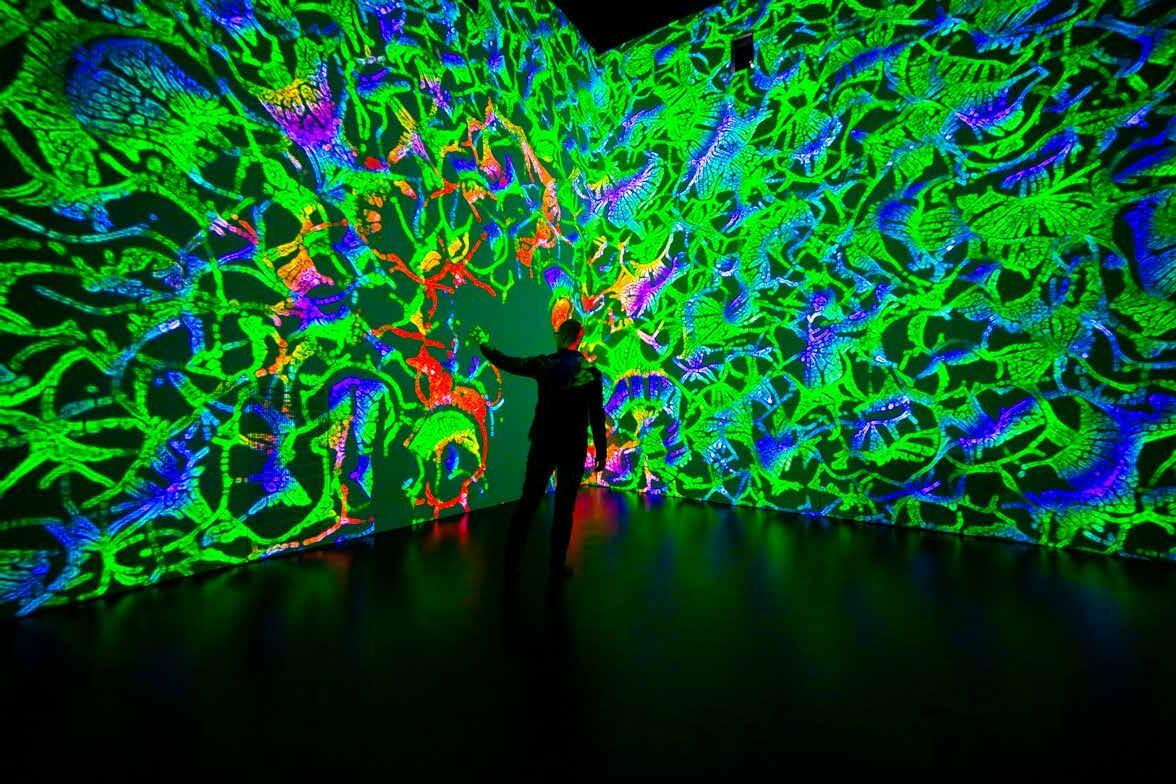
Feldur is a family run fur brand that specializes in the design of high quality fur products. Their flagship store and workshop is located in the heart of Reykjavík where you will find a wide selection of fur products. Inside you can also see the furrier at work, altering and repairing old fur garments giving them a longer life and a new style. ''We believe in the quality and durability of fur as a material that can last a lifetime''.
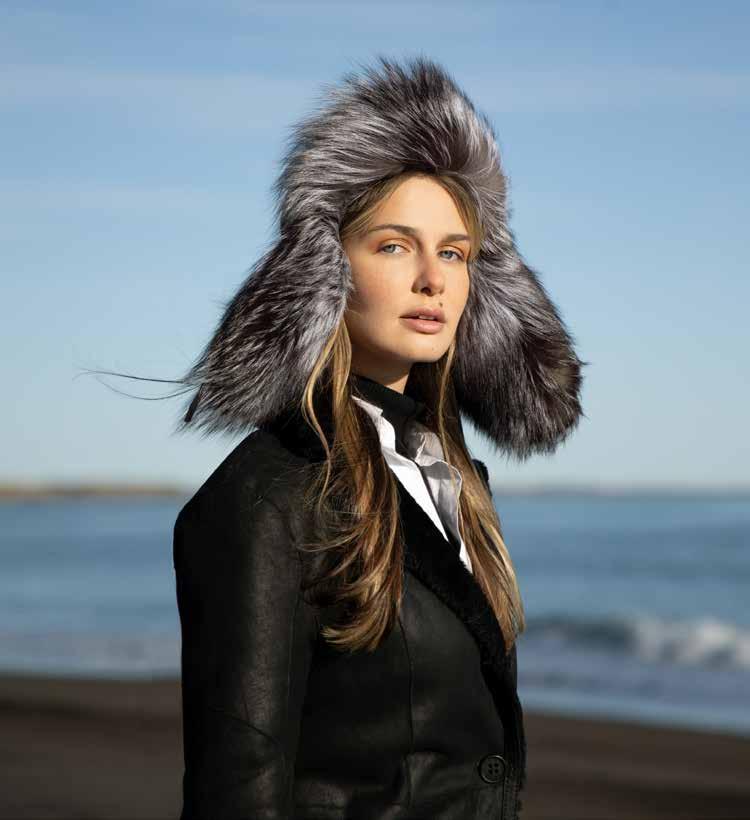
Iceland is having a moment; tourism is booming and travellers can’t get enough of the island’s natural wonders with two recent volcanic eruptions by Fagradalsfjall – Beautiful Valley Mountain – catching the imagination of people on both sides of the Atlantic. Keflavik International Airport is one of the fastest growing in Europe. Isavia that oversees Keflavik International Airport, has reported that over 20 airlines are flying to destinations both side of the Atlantic. The growth post Covid pandemic has been swift. For the month of September 2022, Isavia reported that number of passengers travelling through KEF airport had increased compared to 2019. Iceland is Europe’s most important fishing nation, home to one of the world’s most modern and competitive fishing industries, based on the protection of the marine ecosystem and a sustainable harvest. The fishing industry is one of three main pillars of the Icelandic economy along with and the energy sector that serves the “green“ aluminium industry. Iceland has been a leader in utilising renewable energy for decades, from geothermal to hydropower. During the 20 th century, Iceland went from one of Europe’s poorest countries, dependent upon peat and coal for its energy, to a country where practically all power is derived from renewable resources.
Reykjavík's New Lifestyle Destination 6 Austurvöllur 8
The Iceland Phallological Museum 10
Enjoy the Christmas Spirit 12 Arctic Circle Assembly 2022 14
Best of Iceland 16 64° Reykjavík Distillery 18 A Taste of Thai 20
Anna María Design 21 Aurora Borealis 22
The one and only Grafarvogur 23 Interview with artist Harry Bilson 24 This Beautiful Row of Houses 28
Gunnlaugur Scheving 30 Filming in Iceland 32
A Historical Perspective of Icenland's Whaling 34
That is some achievement in a perilous world. Of that we were reminded at the annual Arctic Circle Assembly in Reykjavík as Nato’s Chief Military Commander, Admiral Rob Bauer reiterated that NATO sees Russia as “...the most significant and direct threat to our security ... including its recent invasion of Ukraine. “ Admiral Bauer said that Russia is NATO’s top threat, but also pointed to China’s increased presence in the region. He asked why China had not condemned Russia‘s invasion. China‘s Ambassador to Iceland Hu Rulong replied that China’s view of the Ukraine crisis included a historic perspective and the world needs to “understand the root cause.” The Admiral pointed out that soon to be, seven out of eight Arctic Nations would be members of Nato with Sweden and Finland joining the Alliance.
The future is bright for Iceland 2023. Our book Best of Iceland was warmly received and is establishing itself as annual publication. For that we are thankful.
Einar Th. Thorsteinsson
Hot Water 36
Sustainable Artisan knifemaking in Iceland 37 Keflavik International Airport 38

Travel in style with Hreyfill Taxi Service 39

Inside Iceland's Renewable Energy 40
Iceland: The Most Important Fishing Nation in Europe 42
Welcome to Suðurnesjabær 44
Fish House by the Harbour 46 Keflavik’s Marriott Hotel 47
ReykjanesbÆr 48
Dalabyggð 52
Krauma Geothermal Baths 54
The First Settlers in Iceland 56 Glorious Dýrafjörður 57 Mystic History 58
Akureyri Heart of the North 60
Spend Time in Fantastic Fjallabyggð 62
Krua Siam 64
Where the Sun Comes Up 66
Explore the Beauty of East Iceland 68 History & Skálholt 70
Skógar Museum 71
A Little Bit of Icelandic Paradise 72 The Volcano Katla is Overdue 73 Skaftáreldar at Laki 74 Árnessýsla Heritage Museum 76
Iceland the Glacieal Country 77 Sagnaheimar Folk Museum 78 Litla Horn 79
Glacier & Geothermal Energy 80 The House that Disappeared 81 The Homely Herd's Lair 82
Icelandic is one of the European root languages, like Latin. There is no ‘c’ or ‘z’ in modern Icelandic, except in foreign words. However, it still contains some letters not found in most other languages. This basic list provides a general idea of their sounds, using familiar words rather than phonetics.
The taste of Icelandic lamb is unrivaled. Our pure bred lambs graze free in the pristine wilderness of Iceland, eating luscious green grass, berries and wild herbs such as red clover, Arctic thyme, sedge, willow, thrift and angelica. The end result is a tender fine-textured meat that is both naturally rich in Omega-3 and iron and infused with the flavor of nature. Icelandic lamb is a taste experience beyond compare.
www.icelandiclamb.is
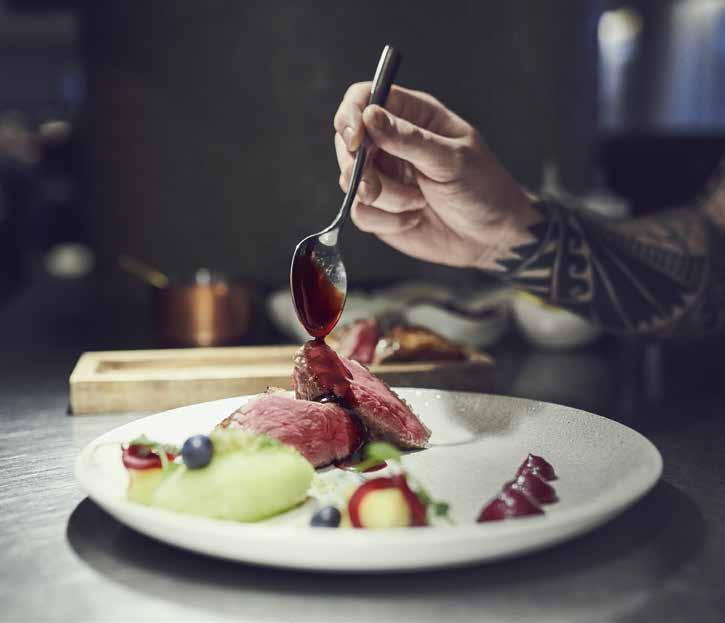


Hafnartorg Gallery is a brand-new elegant space with shopping, food, wine and culture in the heart of the old harbour district in downtown Reykjavík. Here, you can spend the day with over 30 stores and restaurants and tourist attractions nearby.

Premier shops
Hafnartorg Gallery opened in August, marking the latest part of the Hafnartorg area, which has been built up over the last 10 years. It’s home to Iceland’s first and only North Face store. Opening its doors in mid-2022, North Face is a long-awaited addition to Reykjavík’s list of international brands. Furthermore, Iceland’s-own 66 North has its flagship store in Hafnartorg Gallery, where locals and tourists alike outfit themselves in stylish clothing made to withstand Iceland’s elements. For those looking for elegant and unique home furnishings, Casa Boutique offers Icelandic and international designs ranging from luxury tea kettles to artisanal salts to leather handbags.

More shops are located in the Hafnartorg area, including GK Reykjavík, COS, H&M, Levi’s, Bio Effect, Collections, Michelsen, and Optical Studio.
An array of dining options await guests at Hafnartorg Gallery; there’s something for everyone. A brand-new food hall allows visitors to choose from many different types of cuisine. Neo offers New Yorkinspired pizza from Flatey and a great selection of craft beers, and Kualua serves delectable Hawaiian poke bowls. Meanwhile, Fuego uses fresh, authentic ingredients for its Mexican tacos and quesadillas, and Black Dragon is a delightful French-Asian fusion spot. Additionally, three restaurants pair delicious food with carefully-selected wine lists. Akur focuses on French cuisine, while La Trattoria is a high-end Italian restaurant and wine bar, and BRAND is Japanese-influenced wine and grill bar.
Hafnartorg Gallery is close to many of the city’s main attractions, including Harpa Concert Hall for concerts and exhibitions, whale watching tours departing from the harbour, and Kolaportið for shopping in Iceland’s #1 indoor market. Also nearby are the family-friendly favourites Whales of Iceland and FlyOver Iceland. In Hafnartorg, guests can visit the world-renowned Icelandic Phallological Museum and the newly opened Skor, where you can enjoy games of darts, sing karaoke and grab burgers and drinks for a casual time.
In November, Hafnartorg Gallery will begin hosting exhibitions, with the intent
of the space being a centre of culture in the harbour district. Musician Högni Egilsson from the bands GusGus and Hjaltalín will host a show that will combine music with an art installation. Other artists will present shows in the space, bringing an artistic element to the area.
Convenient parking
Hafnartorg Gallery is easy to access as the country’s largest and most advanced parking garage lies beneath the area, with enough spaces for 1,200 cars. Travellers never have to worry about where to leave their rental car when visiting Hafnartorg Gallery. The area also has excellent cycling and hiking trails, and Hafnartorg is wellconnected to the Strætó bus system.
The area is a great starting point for a day of shopping in the city centre, a rest between destinations or a place to enjoy food and drinks before the cultural event. Make sure to spend some time at Hafnartorg Gallery during your trip to Reykjavík. -JG







In olden times, when Reykjavík was simply a farm, Austurvöllur (the East Field) was its best grassfield, and much larger than it is today. It extended over much of what is now the old centre of Reykjavík: from Aðalstræti to Lækjargata, and from Hafnarstræti to the Lake.




When Reykjavík Cathedral was built in 1788-90, rock was quarried nearby and stored on Austurvöllur.
By the early 1800s the field was in a poor state due to overuse and turf-cutting (for construction). As a result the town magistrate banned unauthorised turf-cutting.
In 1806 he stated that it had once been a fine, useful field, but was now nothing but a neglected peat-bog. At that time, dumping of ash and refuse on the field was prohibited, but no other measures were
taken. The field was marshy and uneven, and unsuitable for building.
As the village of Reykjavík grew, it gradually encroached on the field. In the
19th century it served as a campsite for countrymen visiting the town, and also for early tourists.
In 1874 the town council of Copenhagen presented a statue to the people of Reykjavík: a self-portrait by IcelandicDanish sculptor Bertel Thorvaldsen. The town council chose a place for it in the middle of Austurvöllur, and in the summer of 1875 the field was fenced, levelled and turfed, and paths were made. The sculpture was ceremonially unveiled on 19 November 1875, the artist’s birthday. It was Reykjavík’s first public sculpture.
In 1930 the fence was removed, opening the square, and in 1931 the Thorvaldsen statue was moved to the Hljómskálagarður park, to make way for a statue of Jón Sigurðsson (1811-79), leader of Iceland’s
In the early 20th century an artificial skating rink was often created in winter on the square, which was popular with the townspeople.

Many entertainments and social events have taken place on the square over the years, and the people of Reykjavík have traditionally gathered here, in front of Parliament House, whether to celebrate or to protest. At one of the first protest meetings, in 1905, thousands objected to the laying of an undersea telephone cable to Iceland. On 30 March 1949 a protest against Iceland joining NATO led to violence; police used truncheons and teargas on the crowds. Every year people gather on Austurvöllur to celebrate National Day on 17 June, when



a wreath is laid before the statue of Jón Sigurðsson; and in December crowds come to see the lights lit on a Christmas tree, a gift from the people of Oslo.
After the Icelandic economy collapsed in the autumn of 2008, Austurvöllur was again the scene of protests. People gathered, listened to speeches, and hammered on pots and pans to express their rage, in what has become known as the Kitchenware Revolution.
Austurvöllur, in its present form was designed by Sigurður Albert Jónsson, former chief of The Reykjavík Botanical Gardens, and presented to the city by Hafliði Jónsson, former chief of Reykjavík Parks Department; in 1999 the plan was simplified and renewed, to designs by landscape architect Þórólfur Jónsson.
In recent years the City of Reykjavík has been installing plaques at historic sites around the city. The markers display pictures and information about the site’s history, art, literature and social life. This is the information displayed at the Austurvöllur Central Square.
Text and photos: Reykjavík City Museum See more at www.reykjavikcitymuseum.is



The Icelandic Phallological Museum is one of the most unique museums in the world and one of the mostvisited in Reykjavík. The museum contains a collection of more than 300 penises belonging to every species of mammal found in Iceland and scores of foreign species. Visitors to the museum will see specimens belonging to whales, a rogue polar bear, seals and walruses, and specimens originating from many different kinds of land mammals. “The collection began in 1974 and it’s been constantly growing,” said Þórður O. Þórðarson, the manager of the museum. “We have well over 300 penis specimens and 300 penis themed art and cultural pieces.”
The founder, Sigurður Hjartarson, a historian and teacher, began this collection in 1974 when colleagues who worked at the nearby whaling station in West Iceland began giving him whale penises to tease him. The idea of collecting specimens from more mammalian species was born. Collecting the organs progressed and by 1980, he had collected 13 specimens, four from whales and nine from land mammals. In 1990 there were 34 specimens and, when the museum opened in Reykjavík in August 1997, the specimens totalled 62. In the Spring of 2004, the museum moved to the small fishing village of Húsavík, the whale watching capital of Europe.


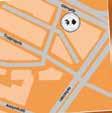
It was moved back to Reykjavík in 2011 and opened under the direction of a new curator, Siguður’s son.
“The first location in Reykjavík was great, but we had to relocate because the collection grew and the number of visitors grew as well,” said Þórður. “We are now located at Hafnartorg, which is a great area of Reykjavík near Harpa.” The museum has undergone extensive changes to improve the visitor experience. There is more space for guests to roam and view the specimens and the technology has been enhanced, with touch screens adding a modernized feel. Another exciting addition has been a phallus-themed bistro where locals and tourists can enjoy food, coffee and beers on tap from local breweries.
A visit to the Icelandic Phallological Museum is a unique, must-see experience when visiting Reykjavík. The museum, which is open every day from 10:00 – 19:00, is a great way to spend a couple of hours in the capital, and it will be a conversation piece for years to come! - JG
The Icelandic Phallological Museum Hafnartorg, 101 Reykjavík +354 561 6663 www.phallus.is


Hafnarfjörður is a picturesque town with a scenic harbour, pretty parks, and interesting museums that are great to visit any time of year. But the town really comes alive in the weeks before Christmas, when it transforms into a winter wonderland.

Hafnarfjörður’s annual Christmas Village is an enchanting experience, with family and friends gathering and enjoying the atmosphere. There is a group of Christmas-designed stalls selling everything from snacks and hot chocolate to Icelandic crafts. It’s the ultimate Christmas market in Iceland; the Icelandic Yule Lads make regular visits to the village, delighting Icelandic children and tourists alike. The Christmas Village has been going strong since it debuted in 2003, and it’s always something to look forward to.
A recent charming addition to the Christmas Village is an ice skating rink, Hjartasvellið. Here, you can rent skates and glide on the rink, soaking in the wintry atmosphere. After some time on the synthetic ice, it’s lovely to sip a hot chocolate and buy some snacks from local vendors at the Christmas Village.
Meanwhile, Hellisgerði will be decked out in its Christmas costume— thousands of lights illuminating the park. Many choose to take a walk through the park before a visit to the Christmas Village to bask in the warm glow of the lights and enjoy the surroundings. The park, which is home to Álfabúðin (The Elf Shop), is delightful to visit, and it’s open over the weekends before Christmas. Here, you can enjoy gingerbread and cocoa,
shop Icelandic crafts and learn about the folklore of elves.
Hafnarfjörður is a bustling, scenic town with a lot to see and do. When not enjoying the Christmas Village, guests can visit museums for free, go swimming, and enjoy the town’s shops, cafes and restaurants. For a bit of culture, the Hafnarborg Center of Culture and Fine Art has two galleries with rotating exhibitions ranging from contemporary art by modern Icelandic artists to works by some of the island’s most celebrated artists of years past.
Visiting the cosiest Christmas town in Iceland is a must during December. The soft Christmas lights and warmth of the town are irresistible. And, it’s easy to get there as there is ample parking for your rental car or if taking public transport, bus number 1 takes you from downtown Reykjavík to the heart of Hafnarfjörður in 20 minutes. The Christmas town of Hafnarfjörður is eager to welcome you on your next December visit to Iceland.








The 2022 Arctic Circle Assembly was held in Reykjavík in midOctober with 2,000 participants from 70 countries attending more than 200 sessions. Ólafur Ragnar Grímsson, President of Iceland [1996-2016] welcomed Crown Prins Haakon of Norway. Other dignitaries were Katrín Jakobsdóttir, PM of Iceland, Múte Egede, PM of Greenland, Alar Karis, President of Estonia and Mary Simon, Governor of Canada. Prins Haakon showed a map of the Arctic saying to the audience: “This particular map is of great importance, not just to the four million people who inhabit this area. It is important to all of us. The Arctic is, in a way, the thermometer of the world. Here, the consequences of climate change are evident. And this map is a compelling image of our interconnectedness as a global community. Both east-west and north-south. Because – when ice melts in the north, the sea level rises in the tropical south.”
Múte Egede, prime minister of Greenland said: “We want growth in Greenland. We want green and sustainable development. This must be on our terms—and you are welcome if you respect and listen to us. When the focus is on Greenland, it is we who are the decision makers. We are the ones who show which direction to go ... Nothing about us, without us. Qujanaq”, meaning goodbye.
“The task is massive,” prime minister Katrín Jakosdóttir said. “Everything is changing! – We see more extreme weather around the globe. Only in the last two weeks, we saw hundreds of trees here in Iceland being ripped up by their roots because of extreme storms in the eastern part of the country. We see glaciers receding, permafrost melting, heat records being set and forests burning. All this is happening much faster in the Arctic, where the ecosystem is sensitive and the resources are great.” She said that Iceland will ban all oil drilling at its Dragon-area south of Jan Mayen by law.
Mary Simon, Governor of Canada, said that as an indigenous person, she calls the Arctic her home. “While the future of the circumpolar region remains bright, we also face many challenges. It will take all of us to make sure we remain on the right path for the benefit of Northern indigenous peoples and everyone else who calls the Arctic their home.”
One of the most intriguing events was NATO’s Millitary Committee chairman’s interaction with the Chinese Ambassador. Dutch Admiral Rob Bauer said, “NATO will not ramp up activity in the Arctic after Sweden and Finland’s accession — unless

Russia makes offensive moves in the region. We will focus first and foremost on properly integrating Finland and Sweden into NATO.” He added that NATO would respond if Russia made the first move. NATO Allies are increasing their focus and capabilities in case of potential escalation in the North. “If the Russian actions basically force us to protect ourselves in a way that is different from what we do now, then that is the reason why we would be more present in the Arctic.”
Bauer said that NATO sees Russia as “...the most significant and direct threat to our security. We are seeing a disturbing pattern of increasingly aggressive behaviour... Russia seeks to destabilize countries through conventional, cyber, and hybrid means — including its recent invasion of Ukraine, which is causing an ...unprecedented level of destruction, violence, and displacement, reminiscent of Europe’s darkest days of the last century, when the rule of force eclipsed the rule of law.” Russia is NATO’s top threat at the moment, but Bauer also pointed to China’s increased presence in the region, including immense investments in energy, infrastructure and research. An Arctic with less ice means naval formations could move more quickly from the Pacific to the Atlantic, and submarines could… shelter in the Arctic everywhere,” Bauer said.

In a question-and-answer session after Bauer’s speech, The Chinese Ambassador to Iceland objected to his characterization, He Rulong said that the admiral’s remarks were “...filled with arrogance and also paranoia.” He argued that China’s activities in the Arctic should not be viewed with suspicion or singled out. Bauer replied: “I have a question for you, because you underline the principle of sovereignty and the importance of the internationally recognized borders in the world,” drawing applause. “I am correct, isn’t that true? Yes. So why is it possible then that China still is not condemning Russia’s attack in Ukraine?” Rulong replied that China’s view of the Ukraine crisis included a historic perspective and the world needs to “understand the root cause,” prompting scattered laughter when he called China “...the peacemaker in the world.”
Bauer said that the two Nordic countries’ close proximity to Russia — especially Finland’s long border with Russia — brought “...centuries’ worth of valuable knowledge and intelligence...” to the alliance, and the nations’ frequent joint military exercises over two decades means the Finnish and Swedish Armed Forces are already highly compatible with NATO. “Soon, with seven out of eight Arctic states being part of this great alliance, we will do everything we
can to make sure the Arctic remains free and open.”


The Admiral received a warm reception from the crowd, the Ambassador, scepticism and laughter. However, they shook hands afterwards and exchanged business cards. “It’s good to speak out and talk when you have different ideas”, the Ambassador tweeted afterwards. Their debate was covered in news media all over the world, not least USA and China. “I know of no other platform where discussions like these between representatives of NATO and China take place, with almost two thousand people present,” President Grímsson said to local newspaper Morgunbladid. “It was a special moment of high tension. All of the sudden, there was lively debate, truth to tell, quite extraordinary. You could hear a needle drop in Harpa’s huge assembly hall. Everyone present knew that this was a historical moment.”
Icelandair and the Arctic Circle Assembly signed an agreement of cooperation with Icelandair becoming official partner of the Assembly. Icelandair will carbon offset all Icelandair flights concerning the Assembly. Icelandair CEO Bogi Nils Bogason said that its domestic flights would become sustainable through electrical powering. Iceland has a great

chance of becoming an electrical hub for flights across the Atlantic. “I’m of the opinion that it is advisable for Iceland to produce more green energy. We would help the world towards reaching its climate goals. Our partnership with the Arctic Circle Assembly is a part of Icelandair’s growing emphasis on sustainability and provides us with an important platform to participate in an active dialogue with key stakeholders, sharing our knowledge and learning from others. Our vision is to bring the spirit of Iceland to the world” CEO Bogason said.
The Arctic Circle Prize 2022 was presented by President Grímsson to the Alfred Wegener Institute and MOSAiC Expedition for their contributions to securing a sustainable and prosperous future in the Arctic and enhancing understanding of the pace of climate change in the world. The Frederik Paulsen Arctic Academic Action Award was awarded at the Arctic Circle Assembly for the second year in row. The Winners of the 2022 Award were Professor Hanne H. Christiansen and Associate Professor Marius O. Jonassen. Their winning project aims to develop an advanced permafrost and meteorological climate change response system in Arctic communities.
- Hallur Hallsson
Best of Iceland is a diverse and informative book with Icelandic Times content about different towns, history, culture, museums, galleries, design, art, poetry, writing, hotels, restaurants and spas. There you can read about Icelandic nature, mountains, rivers, lakes, glaciers, hot springs, volcanic eruptions, fishing, whale watching, hiking, horseback riding, skiing, snowmobiling, the highlands, midnight sun and northern Lights. Interesting content for all about Reykjavík and nearby towns, Reykjanes, the West, the Westfjords, the North, the East and the South.


There is material about our artists Matthías Jochumson, Jónas Hallgrímsson, Halldór Laxness, Gunnlaugur Scheving, Einar Þorsteinn Ásgeirsson and Hallgrímur Pétursson. Also to be found in Best of Iceland are great articles about historic places such as Þingvellir, Skálholt, Hólar in Hjaltadalur and Jón Sigurðsson's Hrafnseyri.

Analysis by Haraldur Sigurðsson, a geoscientist in the United States, on the volcanic eruptions at Fagradalsfjall, amazing highland pictures by Þorsteinn Ásgeirsson, Iceland‘s energy sector in Green Economy, RVK studio and Truenorth serving Hollywood and Iceland:The Most Important Fishing Nation in Europe.
There is also a detailed conversation with former president Ólafur Ragnar Grímsson [1996-2016] about Icelandic energy expansion that is transforming China: The Iceland-China Model. A special co-operation that is taking place between the two countries, it goes on quietly in Iceland but attracts alot of foreign attention. On history there can also be found the classic writings by Hjálmar R. Bárðarson [1918-2009] about Vikings and settlement.
Best of Iceland has a unique position when it comes to the promotion of Iceland with all the opportunities and activities that are available and an overview of tourism that you can not find anywhere else.
An ideal gift for friends, business contacts and travellers in Iceland and abroad.








An independent distillery with unique spirits and liqueurs
64°
Reykjavík Distillery is a family run, independent micro-distillery that handcrafts unique Icelandic-inspired spirits and liqueurs. Popular among locals and visitors alike, the spirits feature flavo u rs including blueberry, juniper, crowberry and rhubarb. The distillery, which was founded in 2009, uses handcrafted processes to create the spirits including natural infusion and
small batch distillation. The ingredients are sourced sustainably, and are proudly foraged locally in Iceland. Great care is spent in selecting the best ingredients as the unique quality and intensity of the berries are key to the rich flavou rs of the spirits. There is a short window for foraging berries in Iceland, so the pickers must time the season perfectly to collect the best berries.
The spirits, which can be enjoyed in mixed drinks or on their own, can be found in the finest restaurants and bars in Iceland as well as in state-run liquor stores.
There is a flavo u r to suit every taste: the blueberry, crowberry and rhubarb liqueurs are on the sweet side and are great for cocktails or to enjoy along with a dessert.

Reykjavík Distillery’s Einiberja (juniper) is a delicious gin that has an elegant, pure, yet intense and crisp flavour. Meanwhile, the company’s Brenniv í n packs a bit of a punch. Distilled from the best organic caraway seeds and local angelica seeds, 64° Brenniv í n is enjoyed neat with traditional Icelandic food. Lately, local and international bartenders have discovered 64° Brennivín, along with other 64° Reykjavík Distillery spirits, to design fantastic cocktails. -JG
Reykjavík Distillery +354 695 1008 info@reykjavikdistillery.is www.reykjavikdistillery.is

Krua Thai serves an enticing cuisine in the heart of the capital city



Reykjavík’s culinary charm is quite impressive for a small city, with a growing number of choices to suit all tastes. While there are traditional Icelandic restaurants serving fresh fish and tender lamb dishes, there are also fantastic restaurants specialising in food that you may not expect to see in Iceland. For instance, Krua Thai features classic and inventive Thai food in Reykjavík.
Quality ingredients, friendly service and a comfortable environment make Krua Thai a favourite among locals and travellers. The menus feature many of the staples you expect to see such as savoury spring rolls, tasty rice and noodle dishes, and glorious plates of Pad Thai. Main courses include delicious options like Pad Grapow, which is a fried dish with chilli and basil leaf in oyster sauce, served with rice and either chicken, pork, beef or lamb. There are also soups and salads on the menu. There is truly something for everyone.
Vegetarian-friendly dining
Non-meat eaters will feel more than welcome as Krua Thai has a large vegetarian section that is big on flavour. For instance, guests can enjoy vegetable noodle and rice dishes, as well as fried vegetables with tofu in oyster sauce, and a spicy v ya salad served with rice.
Krua Thai at Skólavörðustíg 21a, is conveniently located in the heart of city centre, and is a delightful location for a meal. It has a cosy atmosphere and friendly staff who are eager to ensure you have an ideal dining experience. It’s the perfect place for a meal after some time exploring museums, shops, and cafes in the trendiest and liveliest part of Reykjavík. If you want to spend the evening in at your hotel or guesthouse, you can order food to take away, and with delivery. Delivery is available daily until 21:00. -JG
Krua Thai Skólavörðustíg 21a, Reykjavík 101 +354 551-0833 www.kruathai.is
Anna María Sveinbjörnsdóttir is an Icelandic jeweller and designer who runs her own jewellery store, Anna María Design, on one of the main shopping streets in the city, Skólavörðustígur 3, in the heart of Reykjavík. Anna María studied both in Iceland and Denmark and has run her own company for more than three decades.

Anna María's design is pure, timeless and modern at the same time. She stresses exceptional attention to detail and craftmanship and has eye for the smallest detail.
The jewellery is both for women and men and encompass silver, gold, white gold, Icelandic stones as well as precious stones like diamonds. In the store, you can find one of the biggest selections of jewellery with Icelandic stones in the country like Agate, Mose-agate, Jasper, Basalt and Lava.
When it comes to emphasis and style, Anna María mentions free and organic forms based on the Icelandic nature. Iceland is surrounded by the Atlantic Ocean and its waves inspire the jeweller and much of her jewellery where you can see the forms of the waves on rings, necklaces, bracelets or ear-rings.

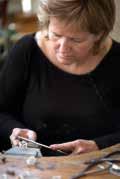
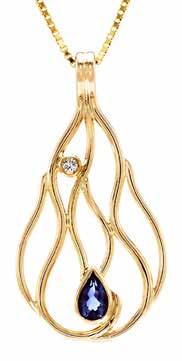

Filigree represents a delicate form of jewellery metalwork usually made in silver and is well known regarding the traditional Icelandic women's costume. In some of Anna María's designs you can find this extraordinary delicate work, which reminds one of the Icelandic heritage. -SJ

One of the most amazing things to experience in nature are the northern lights, aurora borealis. These natural lights at an altitude of 100 km are created when charged particles from the sun collide with atoms and molecules in the Earth's atmosphere. Iceland is located in the northern light belt that surrounds the North Pole, about 2000 to 3000 km away from the magnetic pole. But how and where do you see and photograph the aurora borealis. It is an interaction of many factors. First and foremost, there are usually auroras going on. The Icelandic Meteorological Office has a good aurora forecast (in English and Icelandic) about possible activity. Then, of course, you need clear skies, and if all this is lines up, then you have to settle yourself in a good place, away from built-up areas and light pollution. Then it's just a matter of waiting, with a good tripod, a good camera and a lens that captures the moment when it finally arrives. Yes, the best photos are then created with a little luck, because the northern lights are and will not be controlled. The northern lights are unrelated to terrestrial weather, but of course they are not visible in the summer, when the nights are bright. According to the forecast of the Icelandic Meteorological Office, there is little activity for the next few days.
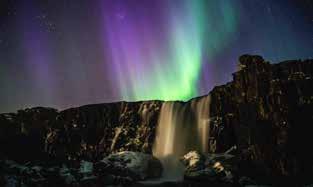
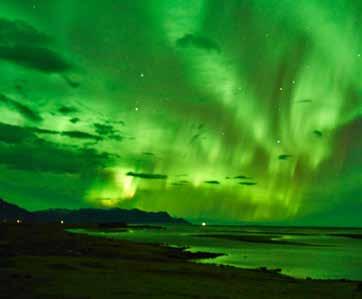
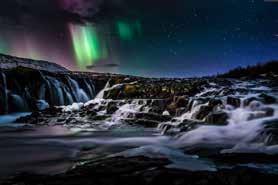
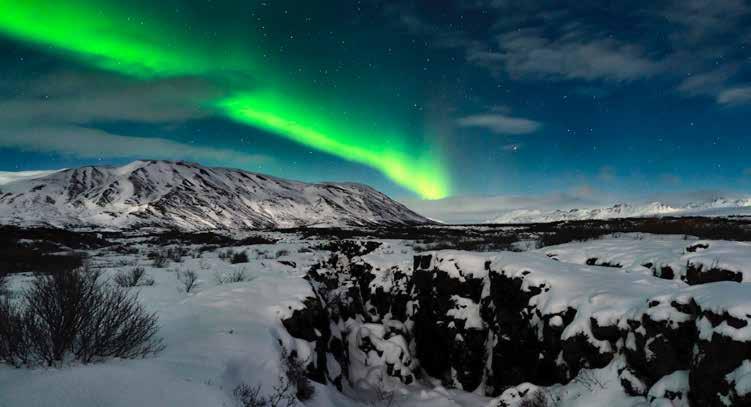
If Grafavogur, a neighbourhood in Reykjavík, were an independent town, it would be the fourth largest in the country. More than 20,000 people live in the area, in a mixed settlement of singlefamily, terraced, and apartment buildings.




Development began in the 1990s and is still ongoing. Now, there is even a Vínbúð (the state liquor store). Residents pointed out a few years ago that there was no such store in the city’s largest neighbourhood. At the same time, Kópasker, one of Iceland’s smallest towns in North Iceland, had one!
Grafarvogur can be broken down into eight smaller districts; Hamrar, Foldir, Hús, Rimar, Borgir, Vík, Engi, Spöng, Staðir, Höfðar, Bryggjuhverfi, Geirsnef, Gufunes and Geldinganes. The last one is the only one still uninhabited, but there are plans for future construction there. The view over Reykjavík and Seltjarnarnes is breathtaking from there. Mount Esja gives Geldinganes, and the whole neighbourhood, good shelter from the cold northern winds.
The Grafarvogur neighbourhood is named after a cove of the same name, which is, itself, named after the now deserted farm, Gröf. It used to stand at the edge of the gorge where Grafarlækur flows into the sea.
Looking across Grafarvogur Cove to the Grafarvogur neighbourhood and the Grafarvogur church. It’s the neighbourhood’s only church and stands by the cove. Mount Esja and Móskarshnjúkar (on the right) can be seen in the background.

The Bryggjuhverfi district stands south of Grafarvogur; you can see Sundahöfn, Reykjavík’s large shipping port, across the cove.
Korpúlfsstaðir was originally a dairy farm built by Thor Jensen around 1925. The City of Reykjavík bought the land in 1942, and it is now an art centre, restaurant and facilities for golfers, while Korpúlfsstaðarvöllur Golf Course is on the old farm fields.
Harry Bilson (b. 1948) receives journalist Helga Kartansdóttir in his studio in Korpúlfsstadir. This is a place where creativity reigns, paintings are scattered around the space, which is both bright and high-ceilinged. Soft classical tunes waft from the radio and the faint scent of incense fills the air. Out of the window you can see Úlfarsfell. “This is my favourite study yet”, Harry informs me while handing me a cup of soothing tea and motioning me to a seat three metres away. I take this opportunity to thank him for agreeing to see me in these last and worst hours of the pandemic. The talk inevitably turns to Covid-19 that is currently shaking the rest of the world, and Harry tells me how the epidemic has affected him.
HARRY: My wife and I have a dog in Cornwall, England, waiting for its owners. Otherwise, the lockdown doesn’t bother me, as I’m happy as long as I can paint. The fact that people seem to be bored really makes me sad because now is the very opportunity to do all the things that have been sitting on the back burner. I myself plan to use the time to review my Icelandic, because even though I have an Icelandic mother, I moved to England at the age of five and soon lost my Icelandic.
HELGA: You have a home in both England and Iceland, but have lived in many places in the world over time. Is traveling the world a lifestyle for you?
HARRY: No, it just kind of evolved and is related to the fact that I've been a working artist for over fifty years. I have travelled
and lived around the world for my work, so you could say that the world is my home.
HELGA: You started painting at a young age and are basically self-taught in the art, how did it come about?
HARRY: I've been very fortunate to be able to work purely on art, although my parents did not want me to become an artist. They encouraged me to study economics instead. However, my mind was headed in a different direction. At first, I couldn't make a living from art alone, so I worked in various manual jobs along with my art. Some of these jobs were so tiring that, at the end of the day, I would rather go to sleep than paint. I exhibited in various places but there was one particular place that gave me a breakthrough and that was Bayswater Road in London. People gathered there on Sundays to look at paintings that had been hung on fences along the street. This place gave me the opportunity to meet people from all over the world and create a network. It also opened my eyes to the fact that it doesn’t mean waiting for others to come to you, but you need to reach out to others.
HELGA: How would you describe your own art?
HARRY: I’ve experimented with different styles and gone from hyperrealism to abstract art. I guess I’m known for a certain style today, but I’m not tied to it. I primarily paint what I like, such as contrasts in colours and unusual image structures; along with the fact that humour is never far away. In my mind,
meaning is not something that the artist communicates to the viewer and sits there. On the contrary, I have learned that people interpret my work in so many different ways that I could never have imagined. Over the years, I have, on the other hand, adopted the problem of the titles of my works, and they are more often than not ambiguous. I focus on titles because I see them as an important link between the work, the viewer and myself.
HELGA: Harry shows me some recent work, but it’s his latest painting that catches my eye. It is called The Quarantree and shows a dark tree in nature. If you look carefully, you can see two black thrushes at the top of the tree at exactly the recommended distance of two metres from each other.
HARRY: I don’t mean to hurt anyone with this piece. However, it has always worked for me to deal with bad things by putting them in a comical context. As strange as it may sound, what is happening in the world today may be that nature is taking control out of our hands because of the trouble we are heading for with all this excess in the production of unnecessary things.
HELGA: Nature has certainly benefited from the governments’ various responses to the epidemic, such as the reduction of air travel.
HARRY: Yes, but also anything related to productivity like polluting industries. It is interesting to think that global warming has been reduced considerably in this short time. It was an American scientist named Carl Sagan who asked Nasa to have the
Voyager satellite take a picture of Earth on its journey to the outer reaches of the solar system. It was a brilliant idea as this photograph shows us in black and white how insignificant the earth is in the grand scheme of things and the same can be said about humanity.
HELGA: Possibly it is the idea that man is in control of nature and should therefore use it as he pleases, which is destroying the earth. However, we do not know nature as well as we would like to pretend.
HARRY: The problem is certainly also related to the idea of our importance. An importance that exists even though we have little weight in the cosmic context. Everything is equally important and everything is interconnected. Some people have ridiculous amounts of money or think that they are therefore more important than others and even treat other people accordingly. The reality is that all people have the same weight. Hopefully these hard times will make people realize that fact better.
HELGA: My time with Harry is running out and I have to admit that, when I say goodbye to him, there is a small hope in my heart that after the pandemic there will be an opportunity to build a world that is in better balance with nature. At least I am convinced that his artistic thinking will take us in that direction. For those who want to learn more about Harry’s work, you can find it on his website www.bilsondirect.com. The works are for sale in Reykjavík at Galerí Fold on Rauðarárstíg.













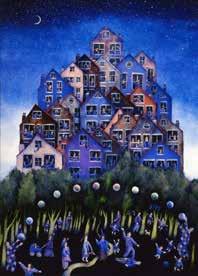
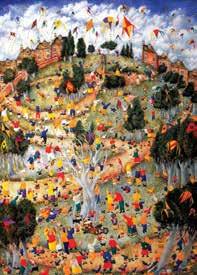

The row of houses that stands on the slope at Lækjargata, above Kvosin, is now called Bernhöftstorfa. The row of houses, from the Government Council, then the Bernhöftstorfan and then the building of Menntaskólinn í Reykjavík, form the oldest complete row of houses in the capital. It was almost 70 years ago that the architect Helge Finsen pointed out that the slope contained almost the only intact street scene from the past, and was therefore well worth preserving, but some of the houses on the turf were not in good conditions at that time. In 1972, the Turf Association was founded to promote the preservation and restoration of the houses. An assessment of the condition of the buildings was made in 1977, that year there was, among other things, a fire on the turf. In 1979, the row of houses was then preserved and the Turf Association entered into a lease agreement with the Minister of Finance and Education regarding the association's takeover of the turf in return for its restoration. That work was fully completed in 1989. The two oldest houses on Bernhöftstorfan are from 1832, followed by one from 1836. Two buildings in the row are younger, both built in 1905.



Looking from Berhöftstorfan, down Bankastræti and towards Lækjartorg.
In Gimli, at front of the photograph, are the offices for the Reykjavík Art Festival are located.


At the beginning of the 20th century, Icelandic art was dominated by landscapes. Born in 1904, Gunnlaugur was to change that dramatically. Raised in East Iceland by a foster family, he adopted their family name, calling himself Gunnlaugur Scheving.
In 1921, his uncle introduced him to Einar Jónsson, Iceland’s leading sculptor. He attended Reykjavík’s first art school and had his first exhibition at only 17. Two years later, he enrolled in the art school in the Danish National Gallery, travelling between Iceland and Copenhagen to raise money for his studies. He entered the Academy in 1925, where he studied under Ejnar Nielsen and Aksel Jörgensen, and met his future wife, Grete Linck.


The artist who challenged traditional views of artSailors in a boat 1947 Sea fog, 1968
Working in the Seyðisfjörður fishing industry in the summers, he sketched the working people around him. Taking his sketches back to Copenhagen, he embarked on a large painting called ‘The Skiff’, that was immediately bought for Listasafn Íslands, the new National

Gallery of Iceland, which now owns his works. Influenced by painters from the French and Italian schools, as well as Whistler, Munch, Krohg and Karsten, he developed his own style, featuring ordinary working people. Later, he illustrated the Icelandic Sagas and

themes of country life, interiors and the Virgin Mary. His last commission was for five paintings for the National Teacher Training College.
He died in December, 1972 and is remembered as a pioneer in Icelandic art.

Iceland’s unique landscape, from bubbling hot springs to erupting volcanoes, attracts film productions from around the world. There’s increasing demand to capture Iceland’s dramatic landscapes in feature films and television series and to take advantage of an attractive incentive scheme.
Over the past few years, some of the biggest movies and television shows have been filmed in Iceland, including Star Wars: The Force Awakens, Thor: The Dark World, Justice League, and Game of Thrones.
Icelandic director Baltasar Kormákur recently opened two film studios in Iceland, RVK Studios, to accommodate the growing demand. RVK Studios has produced the Hollywood films Two Guns, Contraband, and Everest and the Icelandic television series Trapped and Katla.
Iceland may seem like an unlikely location to film, but new productions are announced all the time as the beauty of the island draws them in. Indeed, Iceland’s landscape is unrivalled, from wondrous waterfalls to the desert-like highlands; the contrast of landscapes is breathtaking.

Another Iceland-based production company, Truenorth, has worked on productions including The Northman, Dune, The Midnight Sky, and Blade Runner 2049.
Another part of Iceland’s appeal is due to the Icelandic government’s programme to reimburse up to 35% of the costs incurred while producing films and television programmes in Iceland. Production cost payments to employees and contractors are accepted if they are verifiably taxable in Iceland.
All productions for feature films, television shows and documentaries filmed in Iceland are eligible for a 25% refund, no matter the project’s total cost. To receive 35%, a production must fulfil three requirements, according to the legislation.



First, production costs incurred during the production of the film or television material shot in Iceland must be a minimum of ISK 350 million (EUR 2.5 million). Next, the project must have a minimum of 30 working days in Iceland, either filming days or defined
post-production working days. Of the 30 working days, a minimum of 10 filming days in Iceland is always required.
Lastly, the number of staff working directly on the project should be 50 at a minimum and amount to 50 working days. It is required that both salary and payments to employees and contractors be taxed in Iceland.
Iceland is an increasingly popular destination for filming for a very good reason. Unrivaled scenery, experienced film crews, local talent and impressive tax incentives continue to lure filmmakers.
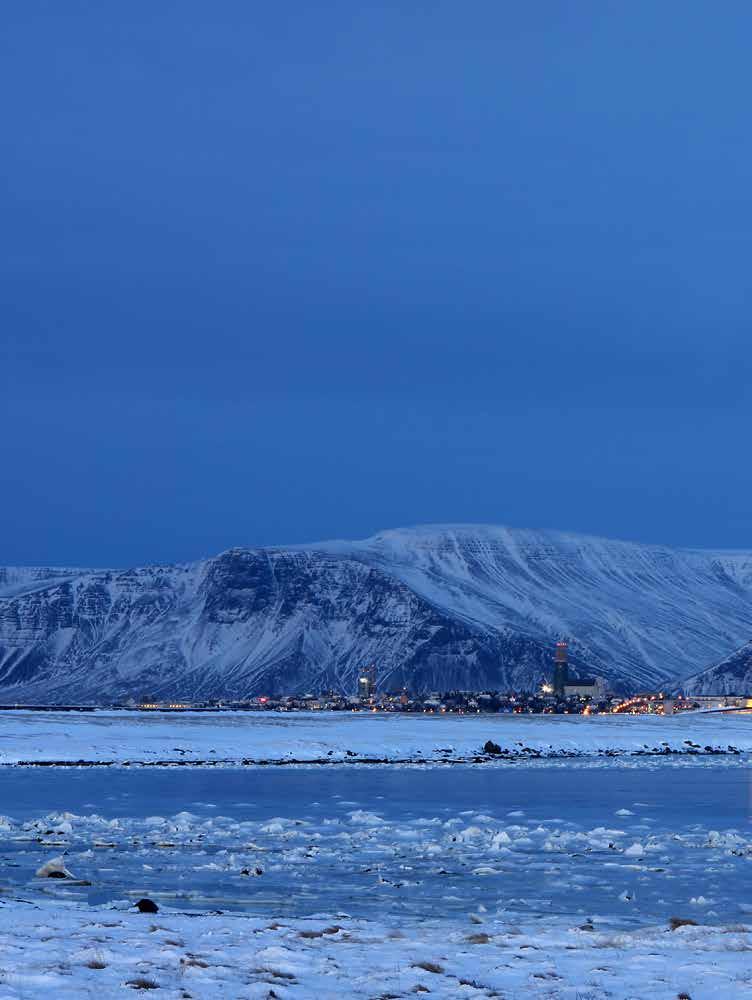

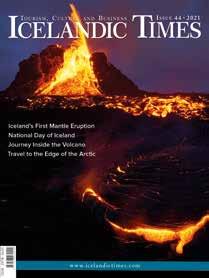
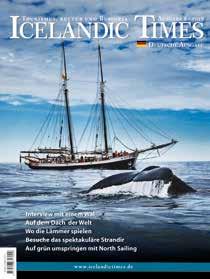

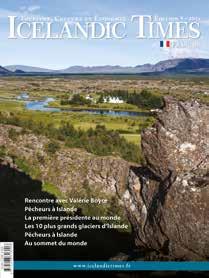
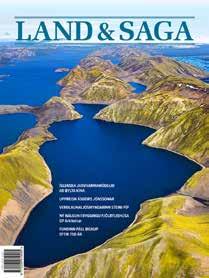
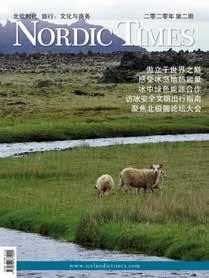
In June 2022 Iceland resumed commercial whaling after halt of four years. Two whaling ships owned by Hvalur hf. (Whale Ltd) – left Reykjavík harbour. 100 days later, the whaling vessels had caught 148 fin whales. Kristján Loftsson, CEO of Hvalur hf. was quoted saying that the whaling season had gone well and the company would resume whaling in 2023. There had been abundance of whales south and south-west of Iceland. The whale hunting quota issued by Iceland’s Marine Research Institute was 161 fin whales. The whaling season ended in September.
As early as the 12th century, Icelanders hunted whales with spears from open boats. Whales would be harpooned and drift ashore. Farmlands situated on isolated


fjords in the Westfjords of Northern Iceland and Reykjanes in the Southwest were sought after because of whale and timber drifting ashore. The Basques started commercial whaling in Iceland after retreating from Newfoundland towards the end of the 16th century. The Basques built whaling stations in the early 1600s; the best known being at Strákatangar (Boys’ cove) at Strandir in the east Westfjords, where tobacco pipes have been excavated. The whalers would sell tobacco and other goods to the locals and buy fish, sheep and wool garments.
The murder of the Basques During the infamous Monopolistic Trade Period between1603-1787, Danes banned ‘foreigners’ as their colonizing
grip on the Icelanders tightened. At the Althing 1615, King Christian IV’s letter was read, banning all foreign whaling off the coast of Iceland. That summer, three Basque whaling vessels were stationed at Strandir in eastern Westfjords, where whale oil was processed. The Basques prepared to leave for their homeland in September, 1615. A severe storm hit the vessels and they ran aground. Eightythree seamen survived, three drowned. The shipwrecked Basques rowed north by Hornstrandir to Ísafjarðardjúp in their small boats, as they had been told that an old sailing ship might take them to their homes. They divided into several groups, one with seventeen sailors staying at Æðey Ísafjarðardjúp (Æder Island), where five of them were killed by locals. Others sailed further to Leirufjörður and fifty-one took over the sailing shipl to take them home. The conditions were harsh and, in order to survive, the Basques committed robberies. The locals
sought them out and in total, thirty-one Basques was killed. It is believed that the rest escaped by boarding a British vessel, returning home in the year 1616.
In the late 19th century, the Norwegians arrived and founded whaling companies, operating fourteen whaling stations on the east and west coasts producing much sought-after whale oil. The first Icelandic Company was established in 1897 but went bankrupt 15 years later. However local
sentiments towards the Norwegians were mixed. In 1913, a total ban on whaling was enacted to preserve whale stocks for Icelandic interests, due to a perceived Norwegian threat. In 1935 a law declared that whales in Icelandic territorial waters could only be hunted by Icelanders.



In 1948 the Icelandic Hvalur hf. (Whale Ltd) purchased the American naval base at Hvalfjörður (Whale Fjord) – north of Reykjavík and converted it into a

whaling station. Hvalfjörður had played a crucial part in the Battle of the Atlantic during World War II. Into the early 1950s, Norwegian crews were involved in training Icelandic whalers. In 1949, the International Whaling Commision – IWC– was established, publishing guidelines for the international regulation of whaling. Iceland was a member of the IWC from the outset. In 1982, the IWC voted in favour of a moratorium on commercial whaling to come into force in 1986. Under pressure from US, Iceland did not object to the ban. However, Iceland submitted proposals to continue whaling for research purposes to be funded by selling whale meat to Japan. The proposal was rejected by the IWC scientific committee.


As Iceland continued whaling, international pressure grew. The conservation group Greenpeace sent their ship, The Rainbow Warrior in protest as did the militant Sea Shepherd Conservation Society. In 1986, the Sea Shepherd group sabotaged the whaling station at Hvalfjörður and sank two whaling boats in Reykjavík harbour. Sanctions followed as international pressure grew.
Iceland left the IWC in 1992 but later made unsuccessful attempts to re-join. In 2003, Iceland proposed to resume research whaling after a 14-year break. Over the next four years Iceland caught minke whales and issued licences for commercial whaling. The struggle continued with protests from USA, UK, France, Germany, Finland, Sweden, Australia and Brazil. The country was at odds with its allies. Iceland returned to commercial whaling in 2013 but stopped in 2020, during the Covid pandemic. Iceland has now resumed whaling and so the struggle continues. However, resistance grows from within.
Early in 2022, Minister of Fisheries Svandís Svavarsdóttir stated in Morgunblaðið that there is ‘little reason’ to permit whaling after the current licence expires in 2023. She claims that whaling is economically of little value and the negative impact is considerable. The government plans to carry out an assessment on the potential economic and social impact of whaling.
When the price of fossil fuels is high and the pollution that such combustion emits into the atmosphere is a serious problem, it is very beneficial to have district heating as 89.6% of all housing in Iceland uses.




Iceland’s first real district heating was installed in Laugaskóli, the school in Reykjadalur, Suður-Þingeyjarsýsla. It was first used in 1924. The first district heating in Reykjavík was in Austurbæjarskóli. A 3 km pipeline was laid from Laugardalur to heat the school in 1930.
Today Veitur operates thirteen district heating utilities, one in the entire capital area, five in the West, and seven in the South. The company serves up to 70% of the population, a truly giant company in its field in the world. The company distributes 89.9 million cubic metres of hot water per year. The length of the district heating pipes is 3,066 km or 1,905 miles, from 78 utilized boreholes. The average annual consumption of Icelandic homes is 4.5 tonnes of hot water per square metre of housing.



whales. If we buy wood, we only buy from specially certified companies in the USA, which can reliably prove that the trees were legally chopped down.” Additionally, they get wood from old trees in Iceland that need to be cut down.
When people think about knifemaking, nature and waterfalls are probably the last things that come to mind. However, that is precisely what you find when you visit Páll Kristjánsson’s and Soffía Sigurðardóttir‘s world-renowned sustainable knife atelier. Situated in the idyllic Álafosskvos in Mosfellsbær, only a 15-minute drive from downtown Reykjavík, the atelier offers some of the best knives you will ever own.
Páll Kristjánsson, or Palli as he likes to be called, has been making knives for over 30 years. His craftsmanship is renowned worldwide, but his knives are unique because he only uses sustainable materials. “Soffía and I use materials that otherwise would be thrown away and
give them a new life”, Palli says. “Some of the materials we use are birch, rowan, horses’ hooves, reindeer antlers, sheep horns and whale teeth.” As a result, every knife is one of a kind and made with Japanese Damascus steel or stainless steel from Denmark, Germany and Sweden.
Soffía Sigurðardóttir’s artisan kitchen knives are made with only the best blades, which have to be handled with care. She is also the only kitchen-knifemaker in Iceland. “I get inspiration from nature and my surroundings when I’m creating the knives. One colour combination of rust-red and green, I got from a ship in the shipyard in the Old Harbour in Reykjavík”, Soffía says.
“Sustainability and the environment are very important to us. No animals are hunted for us. The ram horns and horse hooves come from slaughtered animals, and the ivory comes from beached

It’s not only Palli and Soffía who sell their art in the atelier. Palli’s brother Bjarni is also an artist. His primary medium is ebony and ivory, from which he carves out small animals and other figures. Just like Palli and Soffía, his materials are sustainably sourced.
Visiting the atelier gives a particular sensation of calmness. It is evident the work done there is done with care. The smell of the different woods and leather of the sheaths, combined with the calm sounds of birds chirping and the waterfall, which is literally in their backyard, makes for an exceptional experience. One which is highly recommended. -HDB
Álafossvegur 29 • 270 Mosfellsbæ
Páll Kristjánsson: +354 899 6903 www.knifemaker.is
Soffía Sigurðardóttir: +354 895 7654 www.kitchenknives.is Bjarni Kristjánsson: +354 697 6294 www.bj-art.is
One of a kind knives that will last you a lifetime


Iceland is clearly having a moment; tourism is booming and travellers can’t get enough of the island’s natural wonders. Keflavik International Airport is one of the fastest growing in Europe. During the summer months, Isavia, which oversees Keflavik International Airport, reports that over 20 airlines are flying to dozens of destinations.

The growth after the height of the Covid-19 pandemic has been swift. In September 2022, 653,622 passengers travelled through KEF airport, an increase even compared to the same month pre Covid-19 in 2019. The rapid rise in numbers can be challenging for staff, but there are hard-working and positive staff members working for Isavia and the other companies providing services at the airport. It can be challenging to maintain a high level of passenger satisfaction at a time of very rapid growth for many years. However, it can be seen in the Airport Council International’s Airport Service Quality surveys that the staff work
hard to keep the airport at the same top service level even under a lot of pressure.
Separate from expansion plans, there are several conveniences to enjoy at KEF. For instance, travellers can sign into free Wi-Fi to let friends and family know that they have arrived safely and to catch up on the news. There are numerous eateries at the airport and, after passing through immigration, travellers can get something to eat before going on their way and exploring the natural wonders of Iceland. For instance, the airport is home to international chains Joe and the Juice and Jómfrúin, which serve healthy food options.
Before collecting baggage, travellers can visit the Duty-Free shop, which is located in the same area as the baggage claim. You can buy everything from perfume and candy to alcohol and skincare products, all tax and duty-free.

It is recommended that passengers arrive 2.5 hours before departure, then there is plenty of time to relax and enjoy the commercial area. If you travel with Icelandair or PLAY, you can use the super-easy self-check-in counters and bag drops. Travellers are welcome to sign back into the free wifi and enjoy the many shops, where they can buy souvenirs and gifts to take home for family and friends.
Keep in mind that KEF is one of the few airports in the world where all retail, food and beverage outlets are duty-free for all passengers. You can find all major Icelandic designers and high-end brands like 66 North, Blue Lagoon, and Epal. The shops are both Duty-Free and Tax-Free for all passengers regardless of what passport you may hold or which country you are flying to or from. The Duty Free stores are open according to passenger flights through Keflavik Airport.



Why not skip the rental car in Iceland and book a taxi instead?

Hreyfill taxi offers a personal experience, whether it is to be picked up from Keflavík International Airport or if you want to explore the country. Hreyfill is the largest taxi service in Iceland, as well as one of the oldest, founded in 1943.
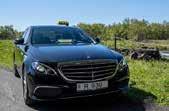

Hreyfill is an excellent option if you want to travel to places off the beaten track or even if you just want a more intimate Golden Circle Tour. Longer or shorter trips are also available, and it is possible to book at short notice. The call centre is open 24/7, so there is always someone who can help.
One of the must-go places to visit in Iceland is the Blue Lagoon, near Grindavík. The lagoon is a great place to relax and eat good food, and having a driver and car from Hreyfill takes the whole experience to the next level. There is no need to plan your trip according to a company’s coach schedule.
No trip is too short or too long. If you just need a ride to the next street over, Hreyfill is
happy to help. It’s possible to order a taxi by phone, via email, through their app or just hail one from one of the many taxi ranks in the city centre. -HDB
Hreyfill Taxi Fellsmuli 26, 108 Reykjavík +354 588 5522 www.hreyfill.is
Iceland has been a leader in utilising renewable energy for decades, from geothermal to hydropower. During the 20th century, Iceland went from one of Europe’s poorest countries, dependent upon peat and coal for its energy, to a country where practically all power is derived from renewable resources.
Generating geothermal energy Generating electricity with geothermal energy has increased significantly in Iceland in recent years. Geothermal power facilities generate 25% of the country’s total electricity production. It took a long road to get there.
“For Iceland, looking for alternative energy sources started with the energy
crisis in the 1970s as fuel prices were going up,” says Dr Guðni A. Jóhannesson, the Director General of Orkustofnun. “There was this national effort to turn from fossil fuels to geothermal energy to heat houses. Today, more than 90% of our heating for houses is from geothermal.”

Iceland’s success in this sector has inspired many countries. “It shows other countries what’s possible,” says Guðni. “We are distributed over an island, with only 360,000 people, and others can see how our investment has paid off. When people in Europe are now suffering from high energy prices because of the situation in Ukraine and the effect of fuel prices on the world market, we are heating our houses at steady prices. It makes a lot of
difference in a cold country, and other countries have looked at us as an example.”
Iceland’s precipitation and extensive vast highlands have an enormous energy potential for hydropower. Much of the rain is stored in ice caps and groundwater and dissipated by evaporation, groundwater flow and glacier flow. In 2014, Iceland’s hydroelectric power stations generated 72% of the country’s electricity production.
“We have also been active in the hydropower sector, and we are working internationally by helping other countries develop hydropower,” says Guðni. “In many cases, hydropower was not very popular due to mismanagement of social

issues and resettlement. Now there is a best practice protocol that makes it easier to implement hydropower.”
Icelandic experts have shared their success in utilising renewable energy sources with countries around the world.

“There have been many opportunities to send our experts to different countries to help them utilise geothermal energy,” says Guðni. “This is significant, especially for developing countries where we lead geothermal training programmes.”
Icelandic experts have travelled to Indonesia, the Philippines, China, and Kenya, among other countries, to provide expert knowledge. “They are building out their geothermal capabilities and needed human resources,” says Guðni. “We can say Iceland has been a major player in these countries, and it’s very important for their economies and contribution to climate change obligations.”
Guðni adds: “We have a model that can be applied to more cities and countries. Those cities with geothermal heating can see that the pollution is significantly decreasing and the air is healthier to breathe.”
Icelandic experts have also helped Canada, the United States, Australia, Tasmania, and some African countries develop hydropower capabilities. “Africa has good potential for hydropower, but some countries need regional and social stability,” he says. “Off these big rivers, there are borders of two or three countries, so there needs to be cooperation between nations.”
The investments are worthwhile for many countries.
“Harnessing geothermal is an investment looked at as rather high, but you have a no-cost resource forever,” says Guðni. “That is, of course, very interesting to many countries, but it takes long-term thinking and commitment to see it through.”
 Friðþjófur Helgason
Friðþjófur Helgason
Fishing
Iceland is home to one of the world’s most modern and competitive fishing industries, based on the protection of the marine ecosystem and a sustainable harvest. Fisheries remain one of the strongest sectors of the Icelandic economy, making it responsible for a large share of both the GDP and the nation’s export revenue. Iceland, which is a small country with just 370,000 inhabitants, is undeniably one of the world’s leaders in total fisheries but has, in recent years, also become a leading country in the advancement of marine technology, fish detection instruments, as well as maintaining a sophisticated fishing sector,
exporting world-class produce around the world. It’s difficult to overstate the importance of fish to Icelanders, and it has been the nation’s backbone throughout the centuries as its chief food supply and main export product. Historical evidence suggests that Icelandic fish export dates back to the 12th century at the very latest, so Iceland has centuries of experience.
The fishing industry is one of the main pillars of the Icelandic economy. According to data released by Statistics Iceland, Iceland is the most important fishing nation in Europe. That year,
www.icelandictimes.com
Iceland was the third largest fishing nation in Europe after Norway and Spain and the 23rd largest fishing nation in the world. China was the largest fishing nation in the world in 2018.
Iceland’s fishing industry is one of the key industries in Iceland and directly employs around 7,500 people or approximately 4% of the total workforce on the island. The fishing industry contributed 8.1% to the GDP directly and 25% if an account is taken of the indirect effects of the ocean cluster. Additionally, in 2020, the export production of marine products amounted to ISK 270 billion (€1.8 billion), a total of 604 thousand tonnes.
Iceland’s exclusive fisheries zone has an impressive 760,000 square kilometres, seven times the area of Iceland itself. Some of the most extensive fish stocks in the North Atlantic are found within Icelandic waters, including halibut, haddock, and cod, which is Iceland’s most important stock.

is one of the pillars of Iceland’s economy, and the country is a leader in fishing sustainability.
The Icelandic fisheries management system was implemented to ensure responsible fisheries, an important issue for Iceland. The fisheries management in Iceland is based on extensive research on fish stocks and the marine ecosystem. Decisions on allowable catches for quotas are made based on advice from the Icelandic Marine Research Institute. Catches are then monitored and enforced by the Directorate of Fisheries. These are the main pillars of the Icelandic fisheries management intended to ensure responsible fisheries and the sustainability of the North Atlantic Ocean’s natural resources.
Rapid advances in Icelandic fisheries have been accompanied by the development of manufacturing and service industries that draw on long experience of the practical needs of fishing and fish processing operations. The fishing fleet is equipped with advanced technology; the same is true for
the processing facilities on land. Among the leading fields are software, electronic and digital equipment, as well as landbased weighing and process control.
A wide selection of packaging for handling storage and retailing of fresh and frozen products are made in Iceland, as well as trawl nets, safety equipment and protective clothing. Icelandic manufacturers have designed and installed many processing plants around the world for companies ranging from vessel owners to industrial food processors.
Sustainable and responsible harvesting of wild fish stocks in Icelandic waters and good treatment of the marine ecosystem are of fundamental importance to Iceland. The fishing industry in Iceland is meeting the demands of buyers for sustainable use of marine resources with the Iceland Responsible Fisheries programme, developed based on commitments made through national law and international agreement.
Fish farming is on the rise in Iceland, as the total production of farmed fish in Iceland in 2017 was nearly 21,000 tonnes. Iceland has taken pride in the fact that several fish diseases are not found in Icelandic-farmed fish, and all reasonable precautions are taken to prevent the introduction of new fish pathogens to the Icelandic aquatic environment.

Atlantic salmon has seen considerable fluctuations in production, from almost 7,000 tonnes in 2006 down to just 292 tonnes in 2008 and 3,260 tonnes in 2015. The production growth has since been high; in 2017, the production reached over 11,000 tonnes. It is expected that salmon will remain the most important farmed species in Iceland over the next several years, with annual production expected to rise to 22,000 tonnes.
Iceland’s fishing industry is thriving and remains one of the most important in Europe.



Suðurnesjabær is one of the four municipalities on Reykjanes Peninsula and lies along the seashore with beautiful surroundings and sea views in the unique Reykjanes Geopark. Suðurnesjabær consists of the two towns of Garður and Sandgerði, which merged in 2018.
Garður is a quiet seaside town on the northwest tip of Reykjanes and a great place to spend some time. The town is known for a pair of lighthouses, where on sunny summer days, you can find locals and tourists picnicking, basking in the sun and enjoying the scenery. The older, more traditional red-striped lighthouse was built in 1897, while the newer squaredesigned one was built in 1944 in a more modern Nordic style. This is a popular destination for photographers and offers good conditions to see the Northern Lights in the wintertime.
The Folk Museum is another must-see in Garður. The museum houses items that were essential for the livelihood of Icelanders on both land and sea, including tools, fishing items, and maps. It offers a window into what life was like in past generations, reminding visitors that life in Iceland was not easy for its early settlers. The museum also has an extensive collection of 60 functional engines provided by local resident Guðni Ingimundarson.
Fishing boats can often be seen from shore—and whales, if you’re lucky! There is rich birdlife in the region, ranging from
hordes of gulls, Arctic terns and gannets in the summer to ravens in the winter.

Meanwhile, Sandgerði offers an insight into one of Iceland’s major fishing communities. Situated on the northern tip of the Reykjanes peninsula, Sandgerði has a lot to do and see in town and a good camping site. Outdoor enthusiasts love the birdwatching and golfing opportunities. There are nature exhibitions at the Suðurnes Science and Learning Centre and a historical gallery.
In the historical gallery, you can visit the magnificent exhibition ‘Attraction of the Poles’ featuring the work, life and death of the French medical doctor and polar scientist Jean-Baptiste Charcot. His
research ship, the Pourquoi-Pas, was lost along the coast of Iceland in 1936 but a model of the boat is part of the exhibition.
Suðurnesjabær, with its beautiful seashore and beaches, is an ideal area to base yourself from while staying along the Reykjanes peninsula.


Fish House Bar & Grill by the harbour in Grindavík, offers not only fish but steaks, great pizzas and burgers, too. The restaurant holds one of the best weekend live music concerts in the country in Gígurinn, ‘The Crater’, an adjoining meeting hall that groups and businesses can also book. Dining guests can be lucky enough to find themselves unexpectedly experiencing concerts or other events that can turn the evening into an unusual, unforgettable experience. On weekends, as the evening goes on, The Crater, being next to the restaurant, turns into a bar, where locals and tourists have fun together.
Grindavík is one of the largest fishery towns in the country. Fishing vessels unload fresh catches ashore numerous times a day. From there, it is only a few dozen metres onto the dishes in the Fish House. It is not only the Fish House that is well located down by the harbour in Grindavík, the town itself is centrally located in the south of Reykjanes, just a few minutes’ drive from the Blue Lagoon and less than half an hour
to Keflavik and the airport. It is much less than an hour’s drive from the capital area. From Grindavík, it is a very short distance to see the new lava that flowed last year from the Fagradalsfjall volcano, just northeast of the town. What is better is that, after a little time outdoors, experiencing Icelandic nature, you can sit down to a good meal at the Fish House.
The menu at the Fish House is very varied. The fish of the day is always a classic favourite, followed by fish and chips with crispy fresh fish, seafood soup and panfried char. Meat dishes on the menu include lamb chops, Haf & hagi or Surf & Turf beef tenderloin with lobster, and lamb steak, a favourite dish of many Icelanders. Then they serve Fish Salad and Chicken Salad, both real burgers and fish burgers and then the volcano, with 140 grammes of beef in Brioche bread. About two dozen pizzas are then on the menu, either to enjoy on site, or to take away.
Fish House Bar and Grill is located at Hafnargata 6, in Grindavík. Meal orders and information can be placed by phone 426 9999. For information, orders or offers for groups it’s best to contact by e-mail: kari@ fishhouse.is





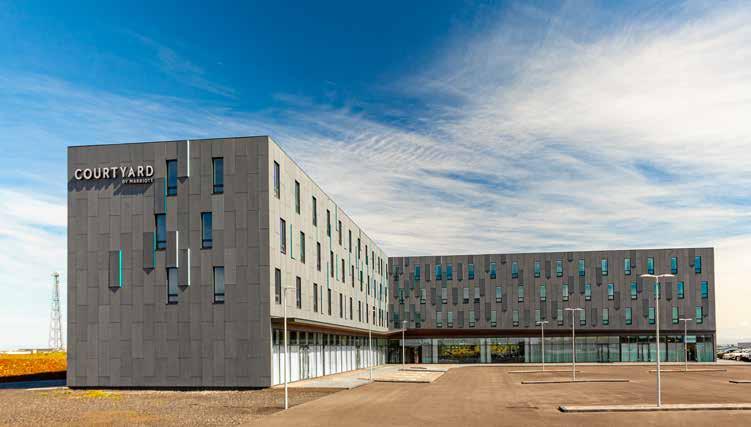
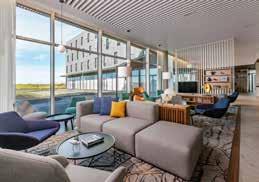
The Marriott Hotel Keflavík is only five minutes away from Keflavík International Airport, thirty minutes from the capitol Reykjavik, twelve miles from the famous Blue Lagoon with the Fagradalsfjall volcano – Beautiful Valley Mountain only few miles further. Close by is the bridge between the continental plates of America and Europe, where literally one can walk from one continent to the other and Clint Eastwood filmed his Flags of our Fathers in tribute to the six soldiers who in 1945 raised the flag on Iwo Jima.
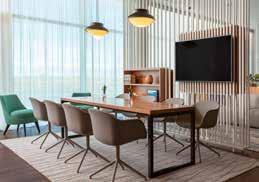
The new state-of-the-art lobby at Courtyard provides greater flexibility and choices for guests. At the center of it all is The Bridge restaurant, for great breakfast, or dinner and drinks during evenings. Guests also


enjoy inviting, flexible spaces whether working or relaxing, free Wi-Fi throughout and easy access to the latest news, weather and airport conditions. Brand-new meeting spaces are perfect for interviews, corporate training and other events. It’s ideal to hold corporate meetings. All rooms offer blackout curtains for quality sleep any time, sleek, tiled bathrooms at choice of a double or twin bed. Whether visiting Iceland for business or pleasure, the friendly staff at Courtyard Reykjavik Keflavik Airport guide guests and help make visit to Iceland a success. -HH
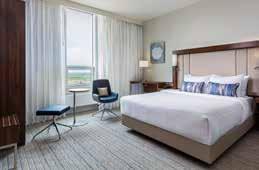
Keflavík’s Marriott Adalgata 60, 230 Reykjanesbaer +354 599 6100
info@courtyardkeflavikairport.is www.Marriott.com/KEFCY
Reykjanesbær, on the Southern Peninsula, Suðurnes, was founded when towns of Keflavík and Njarðvík merged, along with the village of Hafnir, back in 1994. Of these, Keflavík is known to Icelanders as ‘Beatles-Town’, being Iceland’s answer to Liverpool. The reason for that is Iceland’s first ‘Beatlesband’, Hljómar (Chords) was formed in Keflavík back in 1963. The larger-thanlife band members took Iceland by storm. Today, Hall of Hljómar bears their name, housing Iceland’s Museum of Rock ‘n Roll as well–a must visit for lovers of music. Njarðvík or Bay of Njörðr is adjacent to Keflavík, consisting of outer and inner Njarðvík. In its old town is a stone church
built in 1886. Of the three towns that make up the municipality, Keflavík is the largest, while Hafnir is the smallest.
Keflavík and Njarðvík had gradually grown together over the course of the latter half of the 20th century, until all that separated them was a single street. The northern side of the street belonged to Keflavík and the southern side to Njarðvík.
The town, in recent years, has been one of Iceland’s fastest growing municipalities with twenty thousand inhabitants. Ten kilometres away, Hafnir takes its name from two now deserted farms, and was formerly a thriving fishing community up to the 20th century, but today holds only approximately 100 inhabitants.
Iceland’s International Airport is south of Reykjanesbær town. Some five million people will pass through it in 2022, down from seven million 2019. As the covid crisis has passed, predictions for coming years are for up to eight million travellers. Reykjanesbær town serves as a gateway into Iceland, so in recent years excellent hotels and restaurants have begun operations.
The US arrived in Iceland in July, 1941 during World War II. They built Keflaviík Airport but left after the war, returning at the beginning of the Cold War, as Iceland had joined NATO. Keflavík became a United States Naval Base. The Americans

left in 2006, the naval base was closed. The soldiers returned home with their families and staff. They had lived in their own fenced-off town of 5,700 inhavitants. Today, the former ‘American’ town is a thriving district in Reykjanesbær, named Ásbrú (God’s Bridge) with Keilir University, educational institutions and businesses on the site.

of Reykjanesbær
Duus Museum is the Art and Cultural Centre of the town. It houses the exhibition halls for the local museums, concert halls and halls for mixed cultural activities and is located near the marina at Gróf, overlooking Keflavík bay. On the cliffs surrounding the Duus Marina is a foot path where one might catch a glimpse of whales swimming nearby. The oldest of the Duus Houses is the Harbour house, built 1877. Danish merchant Hans Peter Duus [1795-1868] had the house built as a warehouse for Duus company.


There is also the unique Skessa Hellir (Giantess Cave). The design and creation of
the cave and the Giantess were in the hands of the North Storm Art Group., A skessa –a Giantess or Troll woman— is said to have come to the rescue of fishermen during a powerful storm.
Njarðvík is the home of Víkingaheimar – the Viking World Museum with its Viking ship, the Icelander that, in the Millennium year 2000, sailed across the Atlantic to New York to commemorate the thousand-year anniversary of Leif Erikson’s discovery of America. The Icelandic Fire Brigade Museum, with its huge trucks from the time of Iceland’s Defence Force, may be of interest for truck enthusiasts.

At Hafnir village to the south, ruins dating prior to The Settlement are being excavated. The mysterious four-thousandton ghost ship Jamestown stranded at Hafnir in 1881 with no-one aboard. It was crossing the Atlantic bound for Liverpool with high quality lumber. The crew had abandoned the rudderless ship in heavy seas, and four months later it ran ashore at Hafnir.
The Reykjanes Peninsula’s nature is marked by active volcanoes and lava fields. Reykjanesbær is surrounded by unique nature. There are numerous hot springs around the Kleifarvatn lake and the Krýsuvík geothermal area with the geothermal power-station at Svartsengi and the world-famous Blue Lagoon. At Gunnuhver geyser, visitors can hear the vigorous noise, see the boiling water and feel the power and steam bursting from the ground. The geyser stands in the heart of Reykjanes UNESCO Global Geopark, where the North Atlantic Ridge rises from the ocean, with over one hundred different craters and lava fields, bird cliffs, high geothermal areas and black sand beaches. The Bridge between Continents spans the Álfagjá or Elves’ Ravine that marks the boundary of the Eurasian and American continental tectonic plates, enabling visitors to walk from one continent to the other.
The black sandy beaches inspired Clint Eastwood to recreate the battle of Iwo Jima in his movie Flag of our Fathers.
The photograph of the six soldiers who raised the flag on Mount Suribachi on Iwo Jima is arguably the most famous in American history. In his movie, Eastwood follows the stories of the six flag raisers.
The lighthouses of Reykjanes are beautiful structures, the first built 1847 at Garðskagi to guide seafarers into Faxaflói Bay, and the Lighthouse of Reykjanes, built 1878.

Eldey (Fire Island) is a seventy-seven metre-high rock that protrudes out of sea. Eldey is basaltic hyaloclastites, and is 0.3 km² in area. One of the biggest gannet colonies of the world is found at Eldey. It is the innermost of a chain of skerries standing on a shallow ridge, which stretches 45 nautical miles offshore to the southwest. Another of those skerries was Geirfuglasker, where the last breeding colonies of the now extinct Great Auk was located. Geirfuglasker disappeared during submarine eruptions in 1830.

At Hvalsnes (Whale Point), there is a church dear to Icelanders, built with basaltic lava stones and consecrated on Christmas Day 1887. Hallgrímur Pétursson [1614–74], author of the Passion Hymns served at Whale Point. Iceland’s main church, Hallgrímskirkja, in Reykjavík is named after Iceland’s most beloved priest.






Volcanic eruptions occurred in two periods on the Reykjanes Peninsula quite close to Reykjanesbær; from 2020 into 2021 and then in 2022 after nearly 800 years of inactivity. The eruptions were at Fagradalsfjall (Beautiful Mountain Valley). National Geographic’s experts predicted that this “...may mark the start of decades of volcanic activity.” The eruptions were small by Icelandic standards, leading the magazine to predict that these eruptions are unlikely to threaten the towns of the Reykjanes area.
By Hallur Hallsson
When you enter Dalabyggð, you find a region of history and pristine nature, an area where you can be still and relax. Here, you can enjoy silence, nature, and culture— and experience Iceland like the locals do all year round.

The region is especially lovely during the winter, and Dalir transforms into a winter wonderland at Christmas. There’s an enchanting warm feel to the area, with houses and businesses putting up Christmas lights, creating a soft light amid the snow. And, if you’re lucky, you can catch the Northern Lights dancing and flickering in the dark night sky.
You can visit the sites of Auður djúpúðga (Aud ‘the deep-minded’), famously involved in the Saga of Erik the Red and Laxdæla Saga, and see the landscape that affected this intelligent and widely-travelled woman. Or visit the birthplace of Leif, ‘the lucky’ Eriksson, son of Erik the Red, where you can experience the way of life and conditions that his family lived in at Eiríksstaðir.
Look around valleys, beaches and waterfalls and the nature reserves of Breiðafjörður. You might find Holtasóley, the national flower of Iceland or Blóðberg, which is excellent for herbal tea. Before the summer ends, go berry picking for bilberries and crowberries in the hills.



The region is home to two award-winning guesthouses that offer comfortable stays

in the countryside. Nýp at Skarðsströnd was transformed by Studio Bua Architects and won the AIA UK 2020 Design Award. Meanwhile, Drangar Country Guesthouse won the Icelandic Design Awards in 2020, honouring the best Icelandic design and architecture annually.
You don’t have to go off-road to experience everything Dalabyggð offers, but you might get a better sense of everything with a little walk. This is a place to travel slow, take everything in, enjoy, and just be.
Enjoy Iceland’s sublime naturallyheated waters while bathing in geothermal baths in West Iceland. Krauma, the newly opened bathing facility, offers five relaxing natural baths, along with a cold tub, two soothing saunas and a relaxation room, where you can lounge by the fireplace while listening to calming music. This is the perfect way to experience Iceland’s renowned waters in a more intimate setting than the more crowded Blue Lagoon.
The water for the baths is heated by Deildartunguhver, which is considered Europe's most powerful hot spring. It provides 200 litres per second of hot water at 100°C (212°F). To achieve the perfect bathing temperature, Krauma mixes the hot water with cold water from Rauðsgil, which originates in what was the Ok glacier, Iceland’s smallest glacier. Visitors can see Deildartunguhver next to the baths, with its water bubbling up and splashing against bright green moss and jagged rocks. Seeing where the heated water comes from adds to this unique experience. Be sure to keep your distance, though, to avoid being splashed if you get too close.

Deildartunguhver is crucial to the comfort of the region. Most of the water used for central heating in the West Iceland towns of Akranes and Borgarnes is taken from Deildartunguhver. The hot water pipeline to Akranes is 64 kilometres long, which is the longest in Iceland. It’s still about 78-80°C when it reaches the town.
West is best
Krauma is conveniently located in West Iceland, where there are numerous attractions. Starting from Reykjavík, you can make stops at the popular fishing town of Akranes and climb to the top of its lighthouse for spectacular views, before continuing to
Experience Iceland’s geothermal energy in these soothing hot baths
Borgarnes to visit the Settlement Centre to get a taste of the famous Sagas. In Reykholt, one of Iceland’s most notable historical sites, you can stop at the Icelandic Goat Centre before visiting Snorrastofa, dedicated to Snorri Sturluson, one of the most famous and important figures in Icelandic literature. Snorri penned the Edda, Egil's Saga, and Heimskringla before his death in 1241. There is so much to see and do in West Iceland and Krauma is perfectly positioned.
Geology enthusiasts and spa lovers alike will enjoy a visit to Krauma. You can experience nature from its core while bathing in these unique geothermal baths in beautiful West Iceland. Make sure you pay a visit to Krauma during your visit to Iceland. -JG

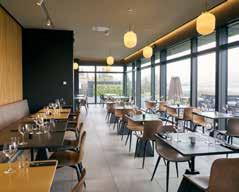
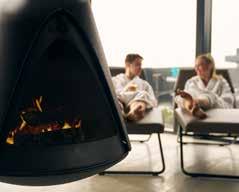
Deildatunguhver, 310 Borgarbyggð www.krauma.is
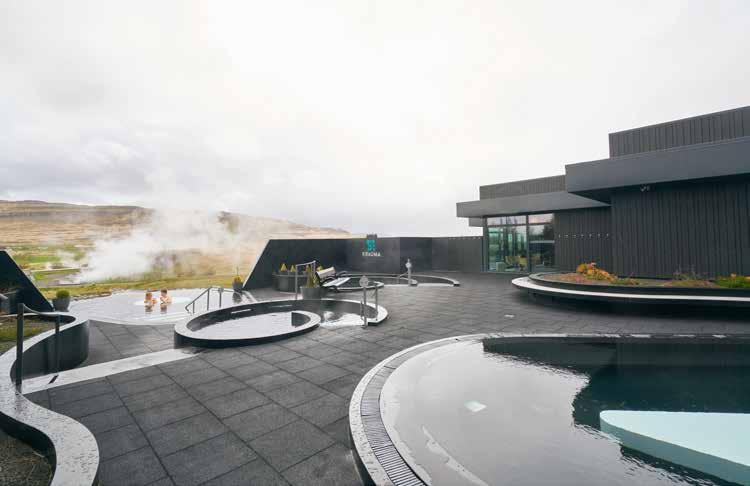



Some 1100 years ago, Iceland was a place covered with impenetrable forests and dangerous bogs, and it took groups of bold men to cross the rough North Atlantic sea, to discover the remote island and determine to settle there in order to start a new life. They were the first to name rivers, mountains and places that are world famous today, and many farms are still able to trace their history back to the days of the Settlement. As the most important source of Iceland’s history, the Sagas are a collection of exciting stories built around these first settlers. Understanding Iceland completely means paying tribute to their achievements, which made the country what it is today.
In 2006 an Icelandic couple, actor Kjartan Ragnarsson and news reporter Sigríður Margrét Guðmundsdóttir, decided to dedicate a project to the story of the Settlement. They found a charming old warehouse in Borgarnes in West Iceland and started building up two exhibitions on the brave pioneers who followed their curiosity into the unknown.
Provided with an audio guide available in 15 languages, visitors find themselves in an elaborate labyrinth that displays history in a
really exciting way. Step onto a moving boat and get the feeling of how it must have been to cross the ocean in an open boat! Listen to stories, while figures behind the glass silently watch over you. On the lower floor the exhibition of Saga hero and settler’s son, Egill Skallagrímsson, takes you right into the story, with Egill’s spirit at your steps.

Transformed through Art Visual artists from Iceland and abroad contributed their work to both exhibitions, transforming it into a unique experience. Each audio tour takes 30 minutes, leaving the visitor with the deep desire to learn more. The Settlement Center’s shop serves as a treasure chest of books on Saga literature, as well as Vikingthemed handicrafts and woolen items created by local artists. Take your time to complete your visit with a dinner in the cosy restaurant that catches the atmosphere of the house perfectly and boasts a range of sophisticated Icelandic food at reasonable prices. -DT/ASF
The Settlement Center
Brákarbraut 13-15• 310 Borgarnes +354 437 1600 landnam@landnam.is www.landnam.is

Dýrafjörður lies between Arnarfjörður and Önundarfjörður in the Westfjords. The fjord is over 30 km long, and 9 km wide at the far end. In the middle of the fjord on the south side, under the mountain Sandfell, is the only town in the fjord, the village Þingeyri, which is now part of Ísafjarðarbær, the most populous municipality in the Westfjords. The fjord is named after the Norwegian settler Dýri from Sunnmæri, who built his



house at Háls. The Westfjords Alps are south of Dýrafjörður, where Kaldbakur is and it is the highest mountain in the Westfjords. From Þingeyri, and west along the fjord is the most rugged road in the country, Svalvogsvegur, to Lokinhamrar and then to Hrafnseyri by Arnarfjörður, the birthplace of president Jón Sigurðsson. Icelandic Times / Land & Saga made a trip to the west, because few fjords, areas are as fascinating as Dýrafjörður.

Reykhólahreppur: Overlooking Breiðafjörður from the Westfjords
The Westfjords’ south coast holds one of Iceland’s rare finds. It’s a small, peaceful community with both natural phenomena and a grand landscape. Over a dozen fjords surround the island-dotted mystical Breiðafjörður Bay with its beautiful scenery, historical and poetic references and exceptional birdlife.
A two and a half hour drive on paved roads from Reykjavík takes you to Reykhólar village, the county’s centre. It provides a full range of services, including a campsite, stores, museums, Sjávarsmiðjan, a unique seaweed spa and a geothermal swimming pool. Quality accommodation, dining and
picturesque views are provided at Hotel Bjarkalundur, Iceland’s oldest summer hotel. Throughout history Reykhólar has been home to many of Iceland’s most prominent chieftains and is frequently mentioned in the Icelandic sagas.
Flatey Island is an important cultural site. A visit takes you back to the year 1900. Reminders of past times include a monastery built in 1172 and Iceland’s first library built in 1864.

A wide variety of species nest around both the coastline of Reykhólahreppur and on the islands of Breidafjorður Bay. One of the most impressive are the majestic and
elusive white-tailed eagles (haliaeetus albicilla), that both nest in the area and can be seen flying over Reykhólar.
Some say Breiðafjörður Bay’s islands are uncountable though cartographers estimate there are around 3,000. There is a 6 metre difference between high and low tides at the time of a spring tide, whereas neap tides reveal far fewer islands. –ASF
Reykhólar • 380 Reykhólahreppur +354 4303200 skrifstofa@reykholar.is www.reykholar.is





The dozen inhabitants in 1786, clinging to the side of Eyjafjörður, Iceland’s longest fjord, probably never imagined their brave struggle would ultimately result in a town of almost 20,000 people with all the services of a major city.
Akureyri is not as big as any of the world’s cities but it provides all the features and services expected of a big city in a very compact form, so that everything is available within a short distance.

Take, for instance, winter activities like skiing. The family-friendly slopes are under 10 minutes from the airport and the hotels. Likewise, the horse riding tours, boat trips, bird watching—to name a few—are all so close, you can almost touch them. You name it, it’s closeby. The weather, with its combination of crisp, dry snow and Northern Lights, makes a holiday here memorable.
Cultural Centre of the North
When it comes to culture, Akureyri has it all: museums, art galleries, international exhibitions, conference facilities, music venues, music of all genres, theatre and cinemas showing the latest films.
It has well over 20 restaurants, covering both Icelandic and international cuisine, with top chefs who create their own innovative cuisine. There is an abundance of cafés, each with their individual speciality.
For groups and individuals, Akureyri offers such a wide range of activities, events and opportunities, it maximises the time available. There are a multitude of tours covering every interest from flying to caving, from fishing to the Hidden People, walking to whale watching.
Sport activities are very popular in the North and many sports are represented in this dynamic community. We have already mentioned the ski slopes, but other popular
facilities are the big skating rink, football fields and recreational areas ideal for running, hiking and downhill biking.
The geothermally–heated swimming pools, with their hot pots, jacuzzi and awesome water slides are open—and very popular—all year round.
The Arctic Open Golf championship is played on the most northerly 18-hole course in the world, just outside the city under both snow–covered mountains and the midnight sun. You can hire clubs if you need them and relax in the club house afterwards.
Akureyri is also a service base for many of the most important tourist destinations in North Iceland. From here, you can visit Mývatn, Dettifoss—the most powerful waterfall in Europe, the islands of Hrísey, and Grímsey, straddling the Arctic Circle; see craters and boiling mud pools and, in fact, reach all the
pearls of the North in under 2 hours. If you are planning your visit, then it’s recommended you check out the Arctic Coast Way with all its wonders. www. arcticcoastway.is.






Flights from Reykjavík airport take just 35 min. Scheduled buses drive twice a day between Reykjavík and Akureyri. The trip from Reykjavík to Akureyri takes about 6 hours, although in the summer time you can choose a longer route over the highlands if you wish to turn your trip into a journey rich with sights and natural beauty.
The city bus service is free in town. Every type of accommodation is on hand, from 4-star hotels to camp sites.
but in the summer, it comes alive with exhibitions, concerts, packed coffeehouses and restaurants.
Siglufjörður and Ólafsfjörður are two small fishing villages on the very northern tip of the breathtaking Tröllaskagi Peninsula, which has a gorgeous mountainous landscape, with some peaks reaching more than 1,400 metres above sea level. The two incredibly scenic villages are part of the Fjallabyggð Municipality, just 76km north of Akureyri. Glaciers and rivers created several deep valleys throughout the peninsula while Tröllaskagi offers opportunities for outdoor activities, including hiking and whale-watching.
Just a one-hour drive from Akureyri, secluded Siglufjörður is the northernmost town in all of Iceland. It’s easy to fall in love with this beautiful harbour town. Siglufjörður’s marina is home to much of the activity in the village, with bustling restaurants and a few town-specific museums focusing on the herring industry and the local music scene. For much of the year, the town of less than 2,000 is quiet,
Culture, museums and summer festivals galore
Siglufjörður and Ólafsfjörður are known for their lively annual summer events that attract visitors from around the world. Here are just a few of the more popular ones:

Siglufjörður is a hot spot and the proud host of many well-known annual events. Their flagship event is, without a doubt, ‘Boating Days’, a family festival held over the last weekend in July with a full schedule of fishing, boating, and herring-related (or not) events. Musical entertainment is mainly provided by renowned Icelandic musicians and artists who perform throughout the weekend.
One of the best museums of its kind in Iceland, Siglufjörður’s Herring Era Museum has a creative and entertaining way of bringing the fishing industry to life. Lively
theatrical performances depicting life and times from the Herring Era of the 1950s are scheduled every Saturday in July.
Historically, music has always played an important role in the lives of Icelanders and continues to do so to this day. Icelanders’ love of music is reflected in Siglufjörður’s Folk Music Centre, located in the former home of the 19th century Reverend Bjarni Thorsteinsson, an avid collector of written folk music and talented composer. Every year in July, the Folk Music Centre holds a Folk Music Festival with participants from around the world giving concerts, lectures and workshops.
The Poetry Centre is open during the summer, and here you can read poems by major Icelandic poets and foreign poets, past and present.
Although Icelandic birdlife is the museum’s primary focus, mounted animals are on display, such as the goat, polar bear and arctic fox, along with fish and crabs. With so much to see and do in Tröllaskagi Peninsula this summer, the detour north promises to be very worthwhile and should not be missed.


Fjallabyggð is the home of a gorgeous slice of North Iceland, with activities and events for the whole family.

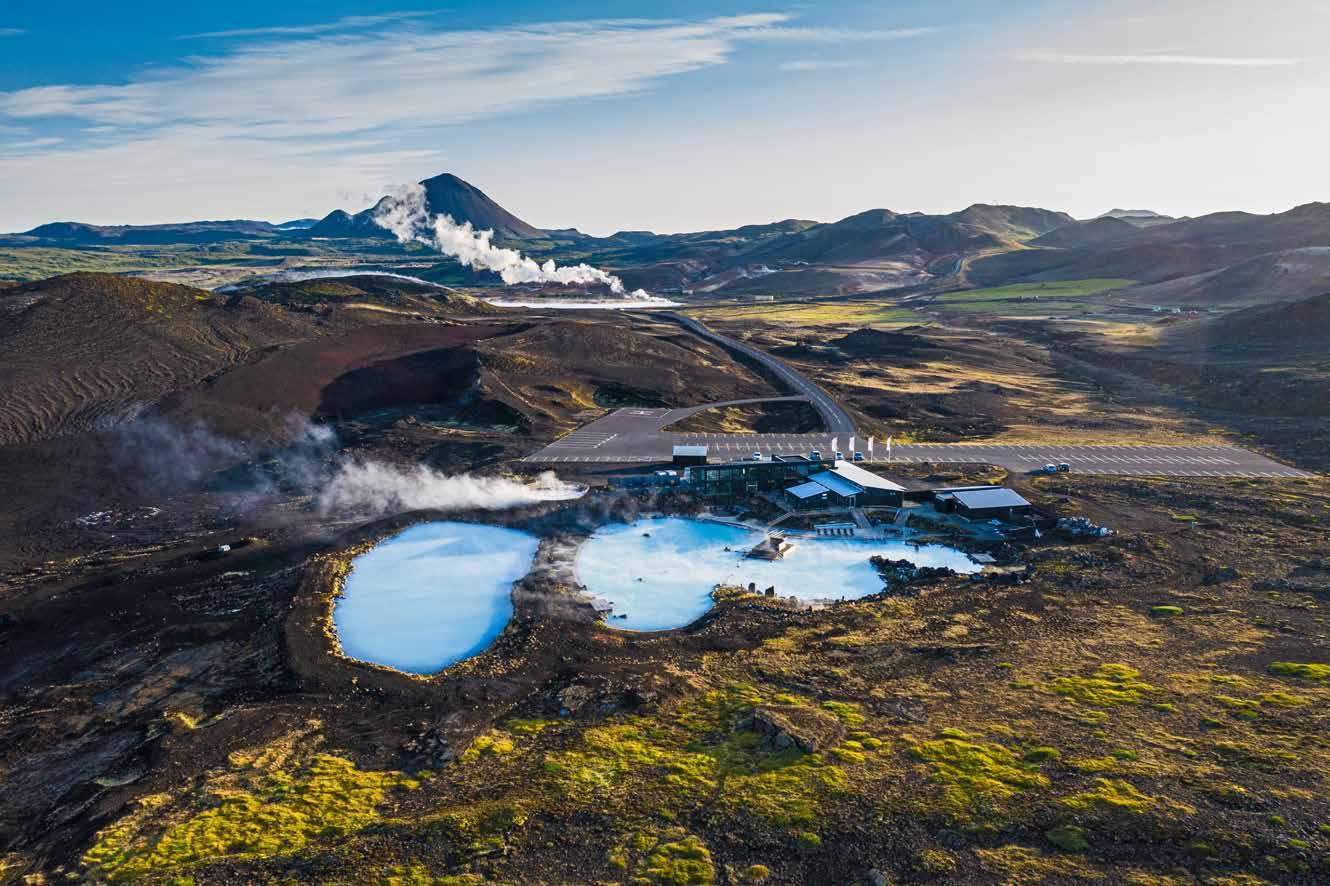




In the heart of the largest town of North Iceland, Akureyri, is the Krua Siam restaurant. The restaurant specialises in authentic Thai food and offers fish, meat and vegetarian dishes.

The name Krua Siam means Siam Kitchen and refers to the name of Thailand until 1939. Many Thai customs involve food. It is common for everyone to order a few dishes, which are then shared among the group; it is even seen as bad luck to eat on your own. It is considered important to not throw away leftovers since it can anger the rice goddess, Phosop. Her role is to
make sure everyone has enough to eat and if she becomes angry, it could mean famine for the whole nation!
Krua Siam offers the option to eat in or take away and has offers for 2 and more people. There is a lunch buffet between 11:30 and 13:30 every weekday with many different courses. You can find dishes with everything from pork, chicken, shrimp, fish and, of course, fried noodles and vegetable dishes, as well.
The restaurant is situated smack downtown on the corner of Glerárgata and Strandgata, near to Ráðhústorgið and

Hof, the Akureyri Cultural and Conference Centre. It is thus a great place to check out during your travels. Enrich your palate with a visit to Krua Siam. –HDB
Krua Siam
Strandgata 13, 600 Akureyri +354 466 3800 kruasiam@kruasiam.is www.kruasiam.is
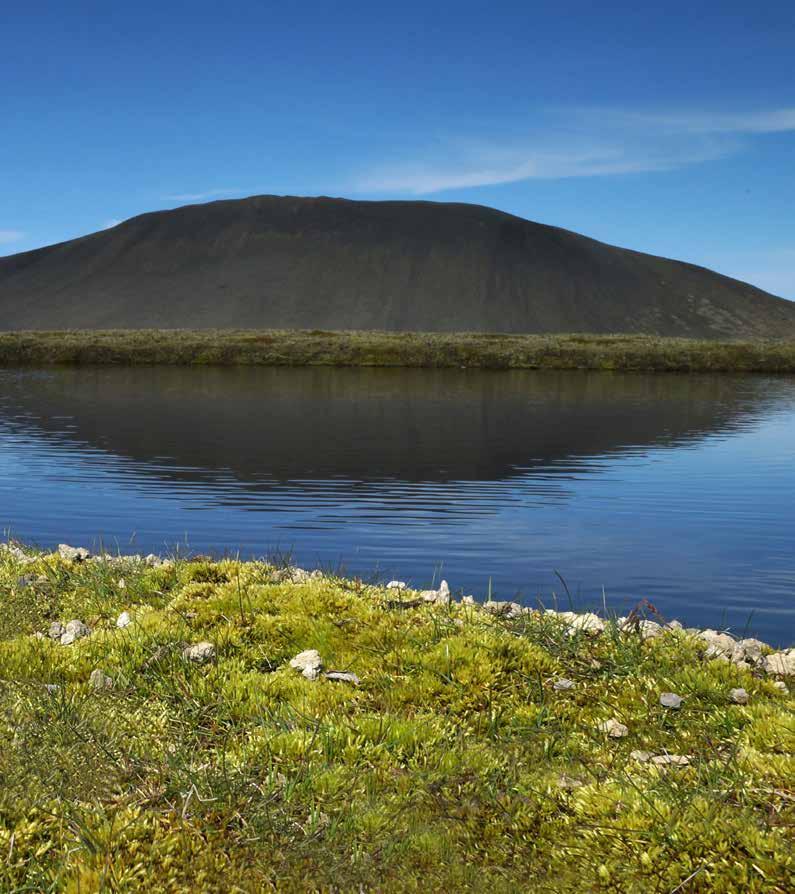

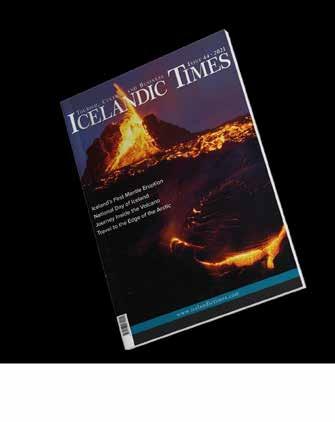
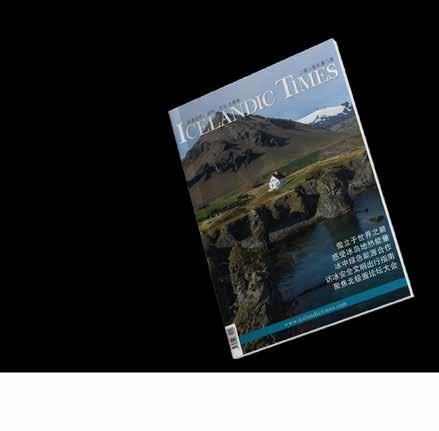
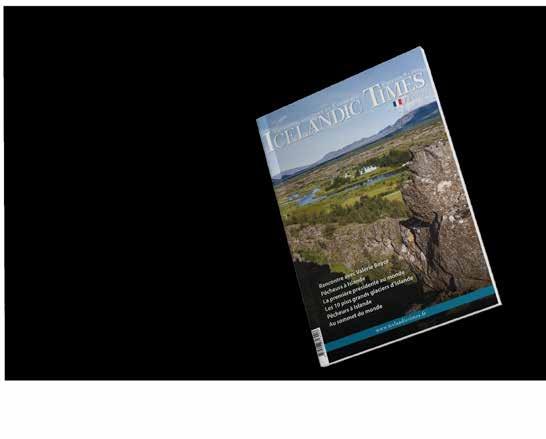
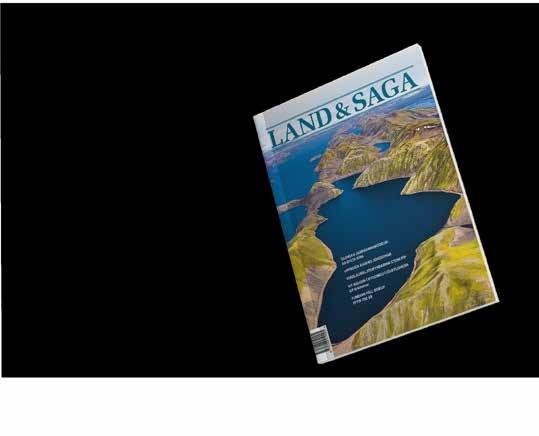
Fjarðabyggð is the tenth most populous municipality in Iceland, with over five thousand residents in the middle of East Iceland, from Mjóafjörður in the north to Breiðdalsvík in the south. Fjarðabyggð was formed in 1998, about a quarter of a century ago, when Neskaupstaður, Eskifjörður and Reydarfjörður merged, followed by Mjóifjörður, Fáskrúðsfjörður, Stöðvarfjörður and Breiðdalsvík.
The fishing industry, aquaculture and the processing of marine products are the basic pillars of value creation in the municipality, as three of the larger fishery companies in the country are located in Fjarðabyggð. Then there is Alcoa-Fjarðaál, with its large aluminium smelter, in Reydarfjörður. The third pillar in the municipality is, of course, the tourism industry that has grown and grown rapidly in a short time, as the area is great for seeing and experiencing the uniqueness of Iceland year-round. Even in the winter, there is skiing in Oddsskarð, the sight of reindeer in the middle of the
It is possible to debate whether Klifbrekfossar in Mjóafjörður is the most beautiful waterfall in the country, that nowhere is the fog more awesome than in Stöðvarfjörður, or that the stillness on Eskifjörður is so complete, the silent and majestic mountains are reflected inverted on its mirror-like surface. But one thing is certain that the sun rises in Iceland first in Fjardabyggð, always.
track, and enjoying the Northern Lights dancing above Skrúð, the island east of Vattarnes, between Reydarfjordur and Fáskrúðsfjörður.
The first protected nature conservancy of the country was established in Fjarðabyggð, in Neskaupstaður. The area around the foot of the Nipan mountain was protected in 1972. Since then, Hólmanes, between Eskifjörður and Reydarfjörður has also been designated a nature reserve. The Gerpis area, the easternmost part of Iceland, between Norðfjörður and Reydarfjörður is becoming one of the most popular hiking



areas in Iceland, both because the area is deserted and because it is laid out with great, well-marked hiking trails, which makes it accessible to tourists and hikers alike. The nature and bird life in the area are exceptional.
What makes Fjarðabyggð especially exciting for tourists is its diversity. The tranquillity and beauty of Mjóafjörður is unforgettable, whether you take the sea route from Neskaupstaður or drive over the Mjófjarðarheiði pass. In contrast, Neskaupstaður bustles with energy. There is always life in the town, whether at the
museum at the harbour, or around the harbour itself. In Eskifjörður, old meets new charmingly in the fjord, creating a picturesque town. Reydarfjörður is the centre of the action, while at the bottom of the fjord between Vattarnes and Hafnarnes lies the town of Fáskrúðsfjörður, where you have to speak French! In the last century, the town was a centre for French fishing boats, fishing the wild Icelandic waters, as there are very good fishing grounds off the East coast. To the south is Stöðvarfjörður, where most travellers touring the country visit the unique and famous Petra’s Stone Collection. Continuing south, in Breiðdalsvík is Meleyri, one of the most beautiful coastlines in Iceland, a three kilometre-long beach with the Sæhvammstind mountains on one side and Sátur mountain with its distinctive peak, on the other. To see the sun kissing the land at dawn is stunning while, because Fjarðabyggð is Iceland’s most eastern municipality, naturally, most other people still only see a morning glow in the sky.






East Iceland is home to some of the most pristine, untouched nature on the island and charming towns with cultural attractions to boot. Múlaþing municipality consists of four villages, Borgarfjörður eystri, Seyðisfjörður, Djúpivogur, and Egilsstaðir, which are can’t-miss destinations in the east of Iceland.



Beautiful Borgarfjörður eystri Borgarfjörður eystri is a gem hidden between spectacular mountains in the east. It is the home of the Atlantic puffin, which can be visited during the summer season. These adorable birds are delightful to see
in their natural habitat. In Hafnarhólmi, guests can get close to the birds, observe them, and get magnificent photos.
Borgarfjörður offers a variety of fantastic well-maintained hiking trails where you can feel connected to nature. As the fjord is the home of hundreds of elves, who knows what one might spot while roaming the beautiful landscape. For those who want to experience the fjord filled with music and people, it is worth visiting during the Bræðslan music festival, which takes place in July every year. Check out borgarfjordureystri.is for more information about the village.
Serene and scenic Seyðisfjörður
Both culture and vibrant atmosphere symbolise the unique fjord Seyðisfjörður. The village buzzes with life during LungA, its annual art festival boasting local and international artists. In addition to the unique festival, it also hosts the LungA School. Exploring the sound sculpture, Tvísöngur combines hiking in beautiful surroundings and engaging art; it is a place where one might be tempted to sing a song or two.
Walking in the fascinating village, down the rainbow street with its cute little coffee houses, market, shops, and restaurants
and into the blue church makes a visit worthwhile. Everywhere is an opportunity to catch breathtaking photos of people, nature, and quirky old houses. Information about nature, attractions, and hiking can be found at visitseydisfjordur.com.
Djúpivogur is a charming fishing village where heritage is celebrated by beautiful old houses, fascinating museums and the idyllic island Papey. For birdwatching enthusiasts, a visit to Djúpivogur is an excellent opportunity to explore various birds; one can even set up in a birdwatching

hut and wait for the perfect photo moment.
Along the coastline towards the harbour, one can see a stunning art piece which consists of 34 granite eggs; it is a replica of the eggs of the birds which lay eggs around the village. In and around Djúpivogur, one can go hiking or enjoy strolls along the black sand beach or the white sand beach. During a walk, one might lay eyes on reindeers and seals. The village and its surroundings are incredibly picturesque.

A gorgeous landscape is the backdrop to countless hiking trails, free to roam and explore. The 1,069-metre (3,507-
ft) Mount Búlandstindur looms over the town, dominating the terrain. Visit visitdjupivogur.is for more information about the village.
Egilsstaðir is considered the unofficial capital and the hub of services and shops in the east of Iceland. With its wide range of options for dining, everyone should find what they desire. It is the home to the domestic airport and a connection to the fjords and other interesting places in the area. In Egilsstaðir, one can relax with a drink in hand at Vök Baths or take the family to the local swimming pool, which prides itself on a slide, two hot tubs, a cold tub and a sauna.
Stuðlagil is an extraordinary place, one of the most stunning sights in the east. The canyon has one of the largest numbers of basalt rock columns in Iceland. Stuðlagil emerged from under the river Jökulsá just a few years ago when the river levels fell, revealing this natural wonder. There is a viewpoint where you can marvel at the darkcoloured columns, which contrast perfectly with the clear blue colour of the river.

Meanwhile, Selskógur is a cute little forest within walking distance on the outskirts of the village. It is a tranquil spot where one can walk along the river and listen to its sound blending in with the lovely tunes of the birds living in the area. Also, Egilsstaðir is situated along a beautiful lake called Lagarfljót that stretches 35 kilometres (21.7 mi) long and offers numerous opportunities for hiking and outdoor recreation. These attractions and more can be found at visitegilsstadir.is.
The east is a paradise for hikers, as there are numerous places to roam and experience the breathtaking nature of the region with few fellow travellers nearby. Be sure to check out the beauty and rich culture of the east during your trip to Iceland.
In Skálholt, the land and history come together. When the Icelandic Times / Land & Saga photographer slipped into the barn at Skálholt earlier today, history became so vivid to him. Here was the bishop’s seat from the early days and, for centuries, Skálholt was the centre for learning and culture in Iceland from 1056 until around 1850 when Reykjavík took over as the country’s educational, cultural, political and financial centre. The largest church in Iceland prior to the 20th century was built at the episcopal seat in Skálholt during the time of Bishop Klængur Þorsteinsson in 1156, using timber that the bishop imported from Norway with two ships that year. This large and magnificent cathedral burned down in 1309. Skálholt still remained the centre of power in Iceland for over 500 years. The large church that is now in Skálholt was consecrated almost 800 years after the fire, as in 1956 it was decided to build a new
church, which was designed by Hörður Bjarnason and consecrated by Bishop Sigurbjörn Einarson in 1963. Sigurbjörn was the bishop of the Icelandic National Church from 1959 to 1981.

Skálholt is a remarkable place for Icelanders. You can feel it immediately when you park in the forecourt. there is the land and the history. Skálholt is just over an hour’s drive south east from Reykjavík.

This year its former director, Þórður Tómason celebrated his 100th birthday
Skógar Museum can be found by the majestic Skógafoss waterfall in South Iceland, 150 kilometres east of Reykjavík. It is a cultural heritage collection of over 18,000 artefacts exhibited in three museums. The Museum displays a variety of tools used for fishing and farming, as well as some artefacts dating back to the Viking Age. There is also the Open Air Museum, showcasing historic buildings from the area, and the Technical Museum, which exhibits many historic vehicles and features from the transportation history of Iceland. This museum is the Crown Jewel of Icelandic regional museums.
The Maritime section of the Folk Museum contains a large collection of objects related to fisheries along the south shore of Iceland. Fisheries in this region were unusual because Iceland’s sandy south coast has no proper harbours; boats had to be launched from beaches open to the North Atlantic waves. The centrepiece of the section is Pétursey, the eight-oared fishing boat, built in 1855 and used until 1946.
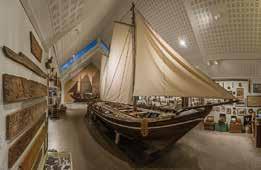
The Agriculture section contains tools and utensils used on farms in past times; riding gear, haymaking tools, woolworking and iron-working equipment. In a subsistence economy, farming households had to be self-sustaining, making and repairing all their own tools and utensils.

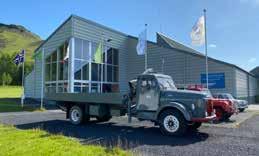
The Folk Museum also has an esoteric collection of everything from textiles to natural history to rare books.
In the original turf houses rebuilt in the Open Air Museum one can catch
the atmosphere of times long gone and experience the living conditions in Iceland throughout the centuries. The Technical Museum tells the story of technology and transportation and its development in Iceland in the 19th and 20th century. Among the many automobiles and two airplanes on exhibit is the world’s best preserved Kégresse P15N track – a must-see for all car enthusiasts!
The Pioneer: Þórður Tómasson Þórður Tómasson was born in 1921 and developed an interest for folk culture from a young age. Growing up in the countryside in South Iceland he started to notice the swift changes taking place in the daily life of what was essentially a farming culture that had not changed for centuries. As working methods modernized and old equipment became redundant, the tendency of the farmers was to get rid of it. Þórður started from a young age to collect old equipment that was being discarded. He also spent a long time listening to the elderly as he was growing up and later started to document this oral history.
In 1944, the residents of the two farms at Ytri-Skógar donated 69% of their land to the counties of Rangárvellir and West Skaftafell, to construct a new boarding school. At the first meeting of the school board in 1945, it was suggested that a folk museum also be established. Skógar Museum was founded in 1949, and the first exhibit was set up in the school basement on December 1st the same year. Initially Þórður Tómasson took responsibility for the museum, and in 1959 he was appointed as director. He was an organist in two churches and, for many years, he was a member of the parish councils of both areas. For ten years he was also a member of the Rangárvellir county council. In 1997 Þórður was awarded an honorary doctorate by the University of Iceland for
his contribution to research in the public interest. Þórður continued his work for the museum until he retired in 2014.
Þórður has written more than 28 books about the old Icelandic farming culture, folklore and the artefacts that can be found in the museum. This year Þórður Tómasson celebrated his 100th birthday.
 -Hallur Hallsson
-Hallur Hallsson
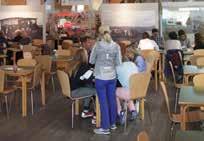
Safnavegur 1, Skógum, 861 Hvolsvelli +354 487 8845 booking@skogasafn.is www.skogasafn.is
Set in one of the most idyllic locations in South Iceland, Hellishólar offers a variety of accommodations for the weary traveller who is looking for a good night’s sleep in peaceful surroundings.
The sprawling Hellishólar property is located 17 minutes from Route 1, near the village of Hvolsvöllur in the middle of Fljótslíð, a picturesque farming district sheltered by three glaciers: Mýrdalsjökull, Eyjafjallajökull and Tindfjallajökull.

Why not bed down for the night in one of Hellishólar’s 25 popular, fully-furnished cottages? Each cottage can sleep from 3 to 6 people and has a small kitchen for making your own meals. If you prefer, you can also eat your meals in the on-site restaurant that serves breakfast, lunch and dinner.
At Hellisholar, there is also a guesthouse and a brand new hotel called Hótel Eyjafjallajökull with 36 spacious and comfortable bedrooms, each with an ensuite bathroom.


The views from Hellishólar are, in a word, stunning! In winter, when the Northern
Lights are visible, one has only to step outside the door and look up. The lack of light pollution makes Hellishólar an ideal location for viewing the Northern Lights.
In summer, the long days bring optimum opportunities to experience the many activities that are possible at Hellishólar— trout fishing on the lake, salmon fishing from the river that runs through the
property and enjoying a round of golf on the 9-hole golf course. Hellishólar is the perfect base from which to explore South Iceland year-round. See you there! -EMV

Hellishólar ehf 861 Hvolsvöllur +354 487 8360
hellisholar@hellisholar.is www.hellisholar.is www.hoteleyjafjallajokull.is


In Katla Glacier is one of the most beautiful and accessible ice caves in the country. The cave is charming, but danger looms above. The volcano Katla is overdue. Icelandic Times / Land & Saga, of course, went south today. You can’t miss seeing such a wonder, like the ice cave in Katla Glacier.


When Katla last erupted in 1918, it was catastrophic. Every hundred years or so, a major eruption happens in Katla, meaning it is over 100 years since there was a large eruption last.
It erupted in 1860, 1823, 1755, 1721, 1660, 1625, 1612, and 1580. Many were enormous eruptions, the largest in 1755 and 934 when there was a giant eruption in Katla. When will it erupt next? No one knows, but it’ll be soon... probably.
Next year, there will be 240 years since one of the biggest volcanic eruptions in Iceland's history began, on June 8, 1783 by the mountain Laki, southwest of Vatnajökull in Vestur-Skaftafellssýsla. The eruption happened on a 25 km long series of craters, the Laki craters, with about 135 craters.


The eruption lasted eight months. The lava field, the Skaftáreldar lava field, is the second largest in historical time where the total volume of the lava is about 13 km³ and its area covers 580 km² of land.
The lava actually has two names, the western part is called Eldhraun, while the eastern part is called Brunahraun. Laki
craters were declared to be preserved in 1971, and are now a part of Vatnajökull National Park. Ash and volcanic fumes caused a lot of mist and fog over Iceland, fog that then later also spread over Europe, America and east to Asia. Heavy pollution accompanied the haze, so livestock fell in great numbers, which in turn led to famine not only here, but all over the Northern Hemisphere. These were the Móðuharðindi, the greatest disasters that have befallen Icelanders before that time and ever since. About 20% of the population died in the Móðuharðindi. It was only a few lifespans ago. Will we get another eruption like this soon? It is up to the whims of nature.


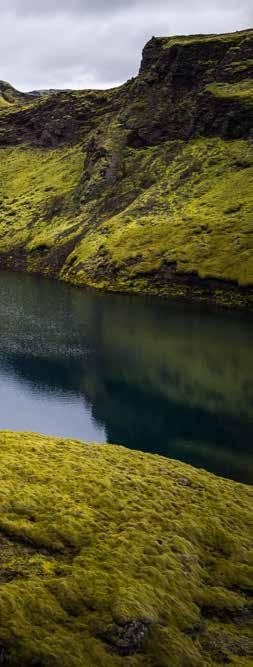


The history of the Árnessýsla Heritage Museum began in 1953, almost 70 years ago. In the beginning, it mainly held objects from the old farming community, with its emphasis on farming, trade and the fishing industry until mechanization. During these 70 years, of course, the emphasis has changed, and now more emphasis is placed on the daily life and households until the middle of the last century. The museum’s first home was in Selfoss, but it was moved to Eyrarbakki in 1995.“Húsið á Eyrarbakki, the oldest house in South Iceland, was built in 1765 and is our main jewel”, says Lýður Pálsson, historian and museum director for 30 years. “These beautiful and unique buildings should be enjoyed, as they are, in fact, the main exhibits. Therefore, special emphasis is placed on the history of Húsið – The House – and its cultural significance in recent centuries.”



When the merchant Jens Lassen built The House in 1765, Eyrarbakki was probably the

largest trading place in Iceland. This was towards the end of the Danish-Icelandic Trade Monopoly, which lasted from 1602 to 1787. During this period, the citizens of the country were not allowed to trade with other merchants or foreign ships. At the time, it seemed that Eyrarbakki would be made the capital of Iceland, as it had a much larger population than Reykjavík.
Two other museums in Eyrarbakki belong to Árnessýsla Heritage Museum. The Maritime Museum, as Eyrarbakki was, through the centuries, one of the largest trading ports in the country, and Kirkjubær, an Icelandic family home built in 1920, where we go back a hundred years and see how ordinary poor people lived. Both museums are within walking distance of The House.
In The House itself, the summer exhibition of the Árnessýsla Heritage Museum is completely modern, as of the Spring of 2022. Artists from nine countries partially transformed the exhibition spaces of The House with works that were created in Eyrarbakki at the Hafsjór - Oceanus Art Festival, which took place this Spring. This was a collaboration between the museum and artist Ásta Vilhelmína Guðmundsdóttir, the festival’s curator.
Does it take time to go back in history and see one of the oldest and most significant houses of Iceland in Eyrarbakki and the other two museums? No, it only takes 45 minutes to drive from Reykjavík, or 15 minutes from the Ring Road from Selfoss. The museums in Eyrarbakki are open every day from 10:59 to 18:02.



Glaciers cover more than a tenth of Iceland. The largest, by far the largest, is Vatnajökull in the southeast corner of the country. It is the largest glacier in the world outside the arctic regions, covering 8000 km2, next in line is Langjökull 950 km 2 , just a few square kilometers larger than Hofsjökull. Number four is Mýrdalsjökull, which is almost 600 km 2 in size. Then comes Drangajökull in the west at Strandir, but it covers 160 km 2 of land. Other glaciers are much smaller. The smallest of the large glaciers and number thirteen in the series is Snæfellsjökull, which is about 3 square kilometers in size. Since 1995, for almost 30 years, Vatnajökull has shrunk by almost one and a half the size of Snæfellsjökull per year.


The Folk Museum of Vestmannaeyjar – the Westman Islands – is a museum built on old traditions. In addition to the many artifacts housed there, today’s technology gives the history and culture a new dimension. While the adults are learning about the stories of fishing, cliff hunting, the Eldfell eruption of 1973 and the Algerian pirate raid of 1627, the children can dress themselves in pirate costumes and search for hidden treasures in the Pirate Cave. Displays and exhibits showing the deep connection with the Mormons, the colourful sports history of the Islands, the reconstructed fishing shack from yester-year or the “Festival” tent where islanders entertain during the annual Þjóðhátíð – National Festival can also be investigated.
At the end of the 19th century, when the population was about 600, great changes took place. In 1904, the first motorised boat was purchased, and more followed soon afterwards. By 1930, the population had risen to 3,470. Now the Westman Islands are Iceland’s most productive fishing centre.

The volcanic eruption in Heimaey shook the Islanders and indeed Icelanders almost fifty years ago. In the early hours of 23rd January1973 the volcano, Eldfell,

erupted on Heimaey and the whole population of 5,300 had to immediately be evacuated to the mainland. That fateful night and the following days are chronicled in an array of photos. There are recordings of Islanders telling their personal experiences of the eruption and the rebuilding of their town in the aftermath.
The Turkish Abduction
Another traumatic event befell on the Islanders 16th July 1627, when three Algerian ships sailed north up the Atlantic to the eastern shores of Heimaey. It is known as the Turkish Abduction because Algiers was under the control of the Turkish Ottomans. Three hundred Pirates disembarked and captured 242 islanders whom they brought to Algeria where they were sold into slavery. The story of this fateful day is vividly captured. The pirate cave is a wonderland for children. One of the captives, Lutheran minister Ólafur Egilsson returned in 1628 and wrote a book about the event. In 1636, ransom was paid for 34 of the captives but most spent the rest of their lives in bondage in the Muslim world. After this, a small fort was built at Skansinn – The Bastion– as armed guards kept watch from Helgafell mountain.
The Islands are famed for their annual Þjóðhátíð – National Festival – which attracts thousands of people from the mainland. The festival was first held in 1874, at the commemoration of the millennium of the settlement of Iceland. For the first time, a Danish King was visiting Iceland: Christian IX, who brought the Icelanders their Constitution that paved the way to sovereign statehood. The Westman Islanders were prevented from sailing to the mainland for the festivities by bad weather, so held their own celebration locally and have done so ever since.
The Mormons also have their historical story exhibited at the museum. The first Icelandic Mormon missionaries, Þórarinn Hafliðason from Vestmannaeyjar and Guðmundur Guðmundsson from Rangárvellir on the south coast, worked in Vestmannaeyjar. Between 1854 and 1914 about 200 Islanders emigrated from the island to the Western World. The Mormon exhibit is in collaboration with Brigham Young University in Utah, along with a large group of enthusiasts who have researched the history and destiny of these pioneers. -HH

One of the most beautiful mountains in Iceland and one of the few places in Iceland where you can find gabbro, (a coarse-grained, dark-coloured, intrusive igneous rock), is situated at Almannaskarð between Hornsvík and Papós. At its foot sits, what at first glance might be thought to be a small Viking village, empty houses from the past, facing the sea.
We are talking about the Vestrahorn mountain range, but the village is, if you look closely, a set that was built over twelve years ago. There are about seven houses of various types in a cluster and interested travellers can access to the area for ISK 900. It's great fun to look around among the houses and imagine the old days of the Vikings.
It is worth noting that in this area, the settler (and perhaps Viking!) Hrollaugur Rögnvaldsson built a town. He was
considered a great ruler and a friend of King Harald according to the description in the Landnáma history book of the Settlement.
The Litla Horn property is privately owned by a local family, who are pleasant and down-to-earth people. Refreshments are offered at the Viking Café, a horse rental is available, as well as a guest house with space for about twenty people, perfect for tourists who want to experience the unspoilt, magical nature of the area.
In winter, this south-eastern part of Iceland is no less popular, as there are many opportunities to see and photograph the Northern Lights dancing above. Watching the green and white lights sweep across the sky is a memorable experience on a frosty night.
There are beautiful hiking trails nearby as well as a unique beach,
owned by the family, where you can see the most beautiful stones – carried by the Hornafjarðarfljót river from the Vatnajökull glacier to the sea, where the pounding waves have rounded and smoothed them for thousands of years.
An area of magic and play.
The Vatnajokull glacier is contrasted by the black sand beach. Geothermal heat flares up from icy banks and the beauty is supernatural in places. The area has been visited by travellers of all kinds, from ordinary campers to representatives of the ‘Game of Thrones’ series, to enjoy the surroundings and preferably, capture on film what they experience.
One thing is certain, the country's history can be found there. The history of settlement, the history of nature and how vast and magnificent it truly is. The hosts welcome their guests, and no one leaves Litla Horn untouched.






Hrafntinnusker is a unique place in Iceland. Hrafntinnusker is the first destination when walking the Laugavegur, the country's most popular highland hiking route, from Landmannalaugar over to Þórsmörk. There is a 12 km well-marked footpath, quite steep, as Hrafntinnusker is the highest point of the Laugavegur, it has an altitude of 1,100 meters. At Hrafntinnusker is the Iceland Travel Association's cabin, Höskuldarskáli, built in 1977. To the south of Hrafntinnusker the closest cabin is by Álftavatn. What makes Hrafntinnusker so unique are the colors, hot springs, glaciers and piles of snow, which are still there in the middle of September even after a good summer. In this area, by Torfajökull is one of the biggest high temperature areas in the country. There is a jeep trail to Hrafntinnusker, but it is only accessible to powerful mountain jeeps and only for a few weeks a year.

None of Heimaey’s 5,300 inhabitants had ever expected that a volcanic eruption could make them homeless. But on 23rd January 1973, earthquakes started to shake the small island south of the Icelandic mainland. Only hours later a 2,000 metre-long crevice opened just outside the town and close to the church, pouring fountains of lava and ash over Heimaey’s houses and streets.
In less than one hour all the inhabitants had been evacuated, without any chance of saving their belongings. Some people never returned to the island.
Two hundred brave men stayed in the danger zone to fight the devastation, and finally succeeded in slowing down the lava flow by cooling it with seawater and thus saved the port. However, when 5 months later, the eruption came to its end, around 400 houses had been completely destroyed.
This volcanic eruption made headlines worldwide, bringing back memories of the Italian town of Pompeii which, in

73 AD, was buried under thick layers of ash and lava from Mt. Vesuvius. Huge parts of that historic site have since been excavated—so people on the Westman Islands rolled up their sleeves and started doing the same.
‘Pompeii of the North’ deserves its name: 40 years after the disaster some 10 houses have been raised from the ashes, and an impressive museum tops off the excavation site that had been open to visitors since the very first dig.
A Museum as a Mirror Eldheimar’s design is unique, rather ominous, and yet austere. It is an archi tectural masterpiece made of volcanic stone that perfectly mirrors the inexorability and harshness of nature. Its beating heart right in the centre of the building is Gerðisbraut No. 10, the house that had been situated on the slope of the lava-spewing volcano. Having been fully excavated, it displays life on the day of the eruption and now serves as a memorial for a lost homeland.
In Eldheimar’s over 1,000m 2 museum, visitors are presented multimedia shows and exhibitions about the Westman
Island’s Eldfjall volcano that, in 1973 rose up to a height of 220 metres out of the blue, not existing before its eruption.


It was similar to the submarine volcano that erupted in 1963 and lasted four years creating the island of Surtsey, south of Heimaey.
Nature protection laws protect Surtsey and only scientists are allowed to access the island for research reasons. The island is part of the UNESCO World Cultural Heritage since 2008.
The Eldheimar museum is quite open in both design and guidance in the exhibition halls as well as in the café and shop. It leaves enough space for walking around and contemplating the natural disaster and its impacts on the economic and cultural life of the Westman Islands, creating respect for the determination of its fearless inhabitants, who still brave the elements today.

Hotel Hjarðarból lies in the South-West between Selfoss and Hveragerði, 30 minutes from Reykjavík
Hotel Hjarðarból – Herd’s Lair – is a friendly family-run guesthouse in the countryside close to Hringvegurinn – The Ring Road or Route #1 – midway between the towns of Hveragerði and Selfoss in South West Iceland, just 30-minutes drive from the capital, Reykjavík. Hotel Hjarðarból has a homely atmosphere reminiscent of a bygone era. R ooms come with shared or en-suite bathrooms. It provides a good base for sight-seeing and exploring around South Iceland and the Reykjanes peninsula and for day trips to Reykjavík, as most of the major attractions are within a relatively short driving distance.
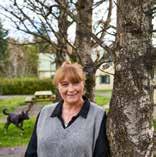





Old farm buildings

Hjarðarból is set in reconstructed farm buildings surrounded by woodland. This laid-back accommodation is in an amazing area of hot springs and waterfalls in Hveragerði’s Geothermal Park with various activities, such as horseback riding and hiking, nearby. Hotel Hjarðaból
features 30 comfortable, down-to-earth and homely rooms with rustic furnishings that vary in size and set up, with double, triple, quadruple, and special family rooms with private or shared bathrooms suitable for all types of travellers.
Built in the 1950s
The Hjarðarból farm was a part of a government project to give people who wanted to be farmers a chance to do so. The Old House was built in the 1950s, a beautiful farm with cattle, horses and sheep. Today’s main building was a barn with two sour-hay towers and a cowshed. The towers are still standing, the barn is now the main hall and the lounge is in the old cowshed. There is also the old sheep shed, where the horses most likely stayed with the sheep. The last ‘original’ house is the shed where tools were kept. This has been converted today into rooms #13-14.
Sigríður Helga, known as Helga, runs this unique hotel with her husband, Guðbrandur Sigurðsson. They have raised three children, lived in Denmark, where they started a restaurant, before returning and taking the risky decision to move their family from Reykjavík and 9-5 work. Guðbrandur is a carpenter. As he has worked in that field for most of his life, renovations haven’t been be a problem. -HH
Feldur is a family run fur brand that specializes in the design of high quality fur products. Their flagship store and workshop is located in the heart of Reykjavík where you will find a wide selection of fur products. Inside you can also see the furrier at work, altering and repairing old fur garments giving them a longer life and a new style. ''We believe in the quality and durability of fur as a material that can last a lifetime''.

